Montessori Toys
Why Does Montessori Use Wood Toys
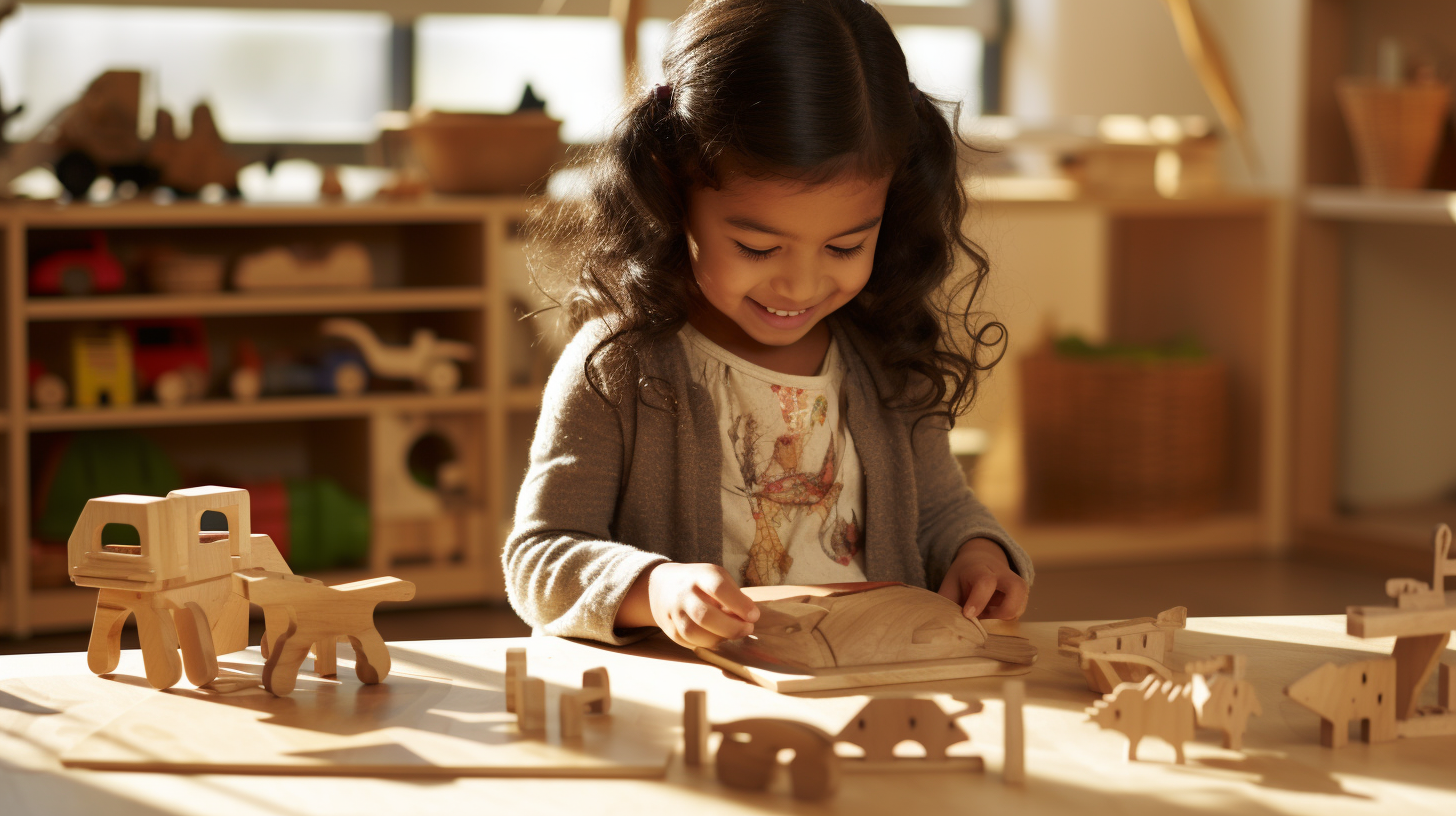
In Montessori education circles, the use of wooden toys is not just a tradition, but a purposeful choice that aligns with the saying, “If it ain’t broke, why fix it?”
I have delved into the benefits of these natural materials and the impact they have on a child’s development. From enhancing sensory development to fostering independent play, wood toys play a vital role in Montessori’s holistic approach to child development.
Join me as we explore the fascinating connection between Montessori and the use of wood toys.
Key Takeaways
- Wood toys in Montessori education foster imagination and open-ended play.
- Natural materials in Montessori toy selection provide sensory stimulation and tactile experience.
- Wood toys enhance sensory development in Montessori by allowing children to explore different textures, weights, and shapes.
- Wood toys in Montessori support creating a natural and sustainable learning environment.
The Benefits of Wood Toys in Montessori Education
You’ll love the benefits of using wood toys in Montessori education. Wood toys play a crucial role in fostering imagination and promoting open-ended play. Unlike plastic toys, wood toys have a natural warmth and texture that engages children’s senses and sparks their creativity.
With wood toys, children have the freedom to explore and manipulate objects in multiple ways, enhancing their problem-solving skills and critical thinking abilities. These toys encourage children to use their imagination, allowing them to transform a simple block into a car, a castle, or even a spaceship.
Open-ended play with wood toys promotes self-expression, independence, and concentration. As children engage with these toys, they develop fine motor skills, hand-eye coordination, and spatial awareness.
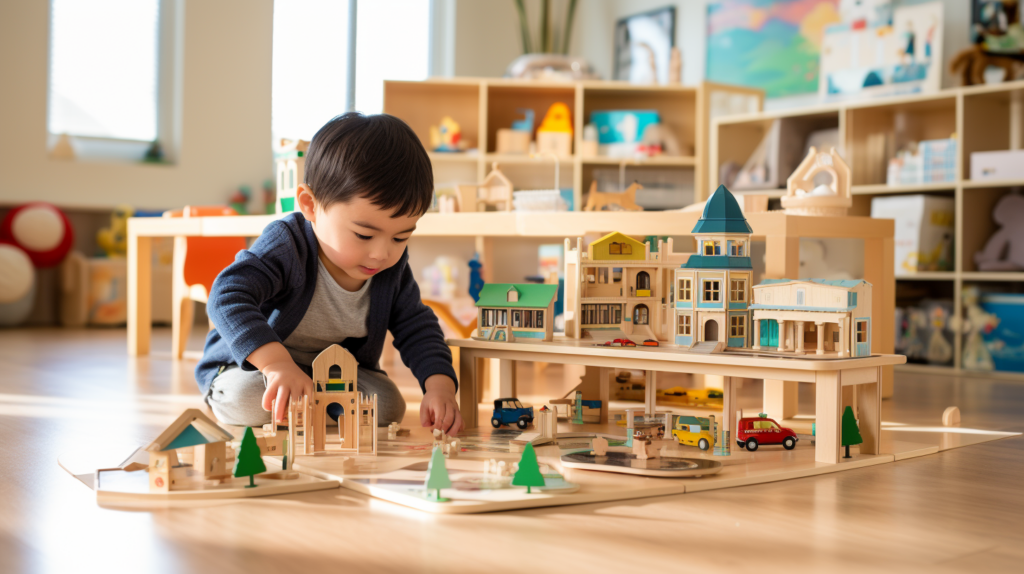
Transitioning to the next section, the role of natural materials in Montessori toy selection goes beyond the benefits of wood toys alone.
The Role of Natural Materials in Montessori Toy Selection
When selecting toys for Montessori education, it’s important to consider the role of natural materials in promoting hands-on learning and sensory exploration. Natural materials, such as wood, offer numerous benefits over plastic toys.
-
Sensory Stimulation: Wood toys provide a tactile experience, allowing children to feel the texture and weight of the materials. This helps develop their sense of touch and enhances sensory exploration.
-
Durability and Longevity: Wooden toys are often more durable than their plastic counterparts, making them a sustainable and cost-effective choice. They can withstand years of play and can be passed down through generations.
-
Environmental Consciousness: Choosing wood toys aligns with Montessori’s emphasis on respecting and nurturing the environment. Wood is a renewable resource, and opting for natural materials promotes sustainability and eco-friendly practices.
By understanding the role of natural materials in cognitive development, Montessori educators can make informed choices when selecting toys for their classrooms.
Now, let’s explore how wood toys enhance sensory development in Montessori.
How Wood Toys Enhance Sensory Development in Montessori
Wooden toys offer a range of sensory experiences, allowing children to explore different textures, weights, and shapes. This sensory exploration is crucial for their cognitive development. As a child interacts with wooden toys, they engage their senses, stimulating their brain and enhancing their understanding of the world around them. The natural materials used in wood toys provide a tactile experience that plastic or electronic toys simply cannot replicate. To illustrate the importance of sensory exploration in a Montessori setting, consider the following table:
Sensory Experience Benefits Touching and feeling different textures Develops tactile discrimination skills Holding and manipulating wooden toys Strengthens fine motor skills Observing the natural colors and patterns of wood Enhances visual perception Listening to the sound produced by wooden toys Improves auditory processing Smelling the natural scent of wood Engages olfactory senses
The Connection Between Wood Toys and Fine Motor Skills
To strengthen fine motor skills, try incorporating wooden toys into your child’s playtime. Wood toys not only provide endless entertainment, but they also play a crucial role in cognitive development.
Here are three ways wood toys can enhance problem-solving skills and promote cognitive growth:
-
Manipulation and Dexterity: Wood toys often require intricate movements and precision to manipulate, such as fitting puzzle pieces together or building structures. These activities help children develop hand-eye coordination and fine motor skills.
-
Imaginative Play: Wood toys, such as blocks or animal figurines, encourage imaginative play that stimulates problem-solving skills. Children can create scenarios, solve challenges, and think critically about cause and effect.
-
Sensory Stimulation: The texture, weight, and feel of wood toys provide sensory input that aids in cognitive development. Children can explore different shapes, sizes, and textures, stimulating their senses and fostering problem-solving skills.
Montessori’s Emphasis on Eco-Friendly Toy Materials
By incorporating eco-friendly toy materials into playtime, parents can support Montessori’s emphasis on creating a natural and sustainable learning environment.
When it comes to toy selection, opting for eco-friendly materials such as wood can have numerous benefits. Firstly, wood is a renewable resource, making it environmentally friendly compared to plastic toys that often end up in landfills. Additionally, wood toys are free from harmful chemicals and toxins commonly found in plastic toys, ensuring the safety of children during play.
Natural materials like wood also provide a tactile and sensory experience, stimulating a child’s senses and promoting their cognitive development. Furthermore, wood toys are durable and long-lasting, making them a wise investment for families.
Transitioning into the subsequent section about the durability and longevity of wood toys in Montessori, these qualities make them an ideal choice for the Montessori method’s focus on sustainable and lasting learning materials.
The Durability and Longevity of Wood Toys in Montessori
In addition to being eco-friendly, wood toys offer a multitude of benefits in a Montessori environment. One of the key advantages is their durability. As a Montessori teacher, I have seen firsthand how wood toys can withstand the test of time and remain in excellent condition, even with frequent use. This durability ensures that the toys can be enjoyed by multiple generations of children, making them a cost-effective choice for schools and families.
Furthermore, wood toys provide tactile stimulation benefits. The natural texture and weight of wood offer a sensory experience that is unmatched by plastic or electronic toys. Children can feel the smoothness or roughness of the wood, enhancing their sense of touch and aiding in their sensory development.
Now, let’s explore how wood toys in Montessori promote creativity and imagination.
Wood Toys and the Promotion of Creativity in Montessori
Immerse yourself in the world of imaginative play with the endless possibilities that wood toys offer. In Montessori education, wood toys are highly valued for their ability to promote creativity and develop problem-solving skills in children.
When children engage with wood toys, they are encouraged to use their imagination and think critically to solve problems. These toys often come in open-ended designs, allowing children to explore different ways of playing and creating. The natural textures and colors of wood stimulate the senses and enhance the sensory experience, further promoting the development of imagination.
As children manipulate and interact with wood toys, they learn to think outside the box, find solutions, and express their creativity. Transitioning into the importance of tactile stimulation in wood toys, these toys offer a unique sensory experience that is crucial for a child’s development.
The Importance of Tactile Stimulation in Wood Toys
As a Montessori educator, I’ve witnessed the numerous benefits that wood toys provide in terms of sensory development. The natural textures and materials used in these toys engage multiple senses, helping children to explore and understand the world around them.
Additionally, wood toys are not only eco-friendly but also promote a connection to nature, fostering a sense of environmental responsibility in young children.
Lastly, the use of wood toys enhances fine motor skills as children manipulate and grasp the objects, improving their dexterity and hand-eye coordination.
Sensory Development Benefits
Wooden toys are great for sensory development because they offer different textures and stimulate the senses. Through tactile exploration, children are able to engage their sense of touch and develop their fine motor skills. The natural materials used in wooden toys provide a unique sensory experience compared to plastic or electronic toys. The smoothness, roughness, and warmth of wood offer a variety of sensations that engage a child’s senses and encourage cognitive development.
Sensory Development Benefits 1 Different textures 2 Stimulates the senses 3 Engages fine motor skills 4 Encourages cognitive development
Natural and Eco-Friendly
Now that we have discussed the sensory development benefits of Montessori wood toys, let’s delve into another important aspect of these toys: their natural and eco-friendly nature.
Montessori toys are designed with a focus on natural aesthetics and sustainable materials. The use of wood not only gives the toys a warm and inviting appearance, but it also aligns with the Montessori philosophy of connecting children with the natural world. Wood is a renewable resource that can be harvested responsibly, making it an environmentally friendly choice. Additionally, wood toys are often made without harmful chemicals or toxins, ensuring the safety of children during play.
By choosing toys made from sustainable materials, Montessori promotes a sense of environmental responsibility and teaches children about the importance of caring for our planet.
As we move into the next section, we will explore how playing with Montessori wood toys enhances fine motor skills…
Enhances Fine Motor Skills
To enhance your child’s fine motor skills, playing with Montessori wood toys provides a hands-on and engaging experience. These toys are designed to promote tactile exploration and hand-eye coordination, which are vital skills for a child’s development.
The use of wood in Montessori toys allows for a natural and sensory experience, as the child can feel the texture and weight of the materials. Through manipulating and grasping the wood toys, children improve their dexterity and coordination. They learn how to manipulate objects in their hands, improving their ability to control their movements and perform delicate tasks.
The combination of tactile exploration and hand-eye coordination in Montessori wood toys creates a holistic approach to fine motor skill development. This foundation is crucial for future learning and sets the stage for the subsequent section on how wood toys contribute to the development of hand-eye coordination in Montessori.
Wood Toys and the Development of Hand-Eye Coordination in Montessori
You can enhance your child’s hand-eye coordination by using wood toys in the Montessori method. Hand-eye coordination is the ability to synchronize the movements of the hands and the eyes. It plays a crucial role in a child’s cognitive development. By engaging in activities that require hand-eye coordination, such as playing with wood toys, children develop their fine motor skills and cognitive abilities.
Wood toys provide a sensory experience for children as they explore different shapes, textures, and sizes. The use of wood also promotes a connection to nature and the environment. In Montessori classrooms, wood toys are often used to develop hand-eye coordination through various activities. Here is an example of a table showcasing different wood toys and the corresponding hand-eye coordination skills they can help develop:
| Wood Toy | Hand-Eye Coordination Skill |
|---|---|
| Shape Sorter | Grasping and placing shapes |
| Stackable Blocks | Building and balancing |
| Puzzle | Matching and fitting pieces |
| Bead Maze | Manipulating and tracking beads |
By incorporating wood toys into a child’s playtime, parents and educators can create opportunities for them to practice and refine their hand-eye coordination skills. This lays a strong foundation for their overall cognitive development.
Transitioning into the subsequent section about ‘exploring cause and effect with wood toys in Montessori,’ children can further develop their cognitive abilities by understanding the relationship between their actions and the outcomes they observe.
Exploring Cause and Effect With Wood Toys in Montessori
When it comes to sensorial development and enhancing fine motor skills in young children, wood toys have proven to be an invaluable tool in the Montessori approach.
The natural texture and weight of wood toys provide a tactile and sensory experience for children, stimulating their senses and promoting their overall development.
Additionally, the manipulation of wood toys, such as stacking blocks or puzzles, requires precise hand-eye coordination and fine motor skills, helping children refine their dexterity and control.
Sensorial Development With Wood Toys
Using wood toys in Montessori education helps to develop a child’s senses and fine motor skills. Wood toys provide a unique tactile exploration experience that engages multiple senses and enhances cognitive development.
Here are three reasons why wood toys are an essential component of Montessori education:
-
Natural Sensory Stimulation: Wood toys have a distinct texture and warmth that provides a rich sensory experience, allowing children to explore different tactile sensations and develop their sense of touch.
-
Environmental Connection: The use of wood toys connects children to the natural world, fostering a sense of appreciation and respect for the environment.
-
Durability and Safety: Wood toys are sturdy and safe, allowing children to freely manipulate and interact with them without the fear of breakage or harm.
Enhancing Fine Motor Skills
Incorporating wood toys into the curriculum enhances fine motor skills and fosters a love for learning.
Wooden puzzles and stacking blocks are excellent tools for developing and refining these skills in young children. The act of manipulating the puzzle pieces or carefully stacking the blocks requires precise hand-eye coordination and control.
As children engage with these toys, they strengthen their hand muscles, improve dexterity, and develop better control over their movements. These skills are essential for future tasks, such as writing, tying shoelaces, or buttoning clothes.
Moreover, the tactile nature of wood toys provides a sensory experience that stimulates the senses and encourages exploration. This hands-on approach to learning not only enhances fine motor skills but also ignites a curiosity and passion for learning in children.
Transitioning into the next section, wood toys also play a crucial role in Montessori language development.
The Role of Wood Toys in Montessori Language Development
Wood toys play a crucial role in Montessori language development because they engage your child’s senses and promote hands-on learning. When it comes to cognitive development, wood toys provide the perfect opportunity for children to explore various shapes, sizes, and textures. This tactile experience helps them develop their cognitive skills by enhancing their ability to recognize and differentiate between different objects.
Additionally, wood toys also have a significant impact on emotional development. Through imaginative play with these toys, children can express their emotions and develop their storytelling abilities. The natural feel and warmth of wood toys create a calming and comforting environment, fostering emotional well-being.
As we delve into how wood toys foster independent play in Montessori, it is important to remember the pivotal role they play in language and emotional development.
How Wood Toys Foster Independent Play in Montessori
To foster independent play in Montessori, you can encourage your child to explore and engage with a variety of play materials, such as wooden blocks or puzzles. Independent play is a crucial aspect of Montessori education as it allows children to develop important skills, such as problem-solving, creativity, and decision-making.
By providing them with open-ended toys like wooden blocks, children are given the freedom to use their imagination and explore their own interests. These toys also promote fine motor skills and hand-eye coordination as children manipulate the blocks to build structures or solve puzzles.
Through independent play, children gain confidence in their abilities and become more self-reliant. This lays a strong foundation for their future learning and development.
Transitioning into the subsequent section about Montessori’s holistic approach to child development through wood toys, we can see how these toys play a vital role in fostering a child’s overall growth and learning.
Montessori’s Holistic Approach to Child Development Through Wood Toys
As an expert in child development, I’d like to discuss the benefits of using wooden toys and how they provide sensory stimulation for children.
Wooden toys offer numerous advantages, including durability, safety, and ecological sustainability.
Additionally, the natural texture and weight of wood provide a rich sensory experience that promotes fine motor skills and encourages exploration and creativity in young minds.
Benefits of Wooden Toys
One of the benefits of using wooden toys in the Montessori method is that they provide a tactile and sensory experience for children. This hands-on exploration allows children to engage their senses and develop their fine motor skills.
The advantages of using wooden toys go beyond the physical benefits. They also promote creativity and imagination, as children can use the toys in various ways and create their own stories. Additionally, wooden toys are durable and eco-friendly, making them a sustainable choice for parents.
The natural textures and colors of wood create a calming and inviting environment for children to play and learn. Transitioning into the subsequent section about sensory stimulation with wood, we can explore how these toys enhance children’s cognitive development.
Sensory Stimulation With Wood
In addition to the benefits of wooden toys that I mentioned earlier, another reason why Montessori education emphasizes the use of wood is because it provides ample opportunities for tactile exploration, which is crucial for cognitive development. The texture and weight of wood allow children to engage their senses and develop their fine motor skills. When children manipulate wooden toys, they are not only visually stimulated, but they also get to feel the smoothness or roughness of the surface, enhancing their sensory experiences.
To give you a better understanding, here is a table that illustrates the connection between tactile exploration and cognitive development:
Tactile Exploration Cognitive Development Manipulating wooden toys with different textures Enhances sensory processing skills Feeling the weight and balance of wooden objects Develops fine motor skills Exploring the different shapes and sizes of wooden toys Encourages spatial awareness and problem-solving abilities
Frequently Asked Questions
Are There Any Benefits of Using Non-Wood Toys in Montessori Education?
Using non-wood toys in Montessori education may have some benefits, but there are also disadvantages to consider.
Non-wood toys can offer a wider variety of textures and materials, enhancing sensory exploration. They may also be more affordable and accessible.
However, wood toys have unique advantages in promoting fine motor skills, durability, and a connection to the natural world. They are also more environmentally friendly and free of harmful chemicals.
Overall, a balance between wood and non-wood toys can provide a well-rounded learning experience.
How Do Natural Materials Other Than Wood Play a Role in Montessori Toy Selection?
Natural materials play an essential role in promoting sensory development in Montessori toy selection. Wood toys are commonly used, but other materials like fabric, metal, and clay are also incorporated. These materials provide a variety of textures, weights, and temperatures, stimulating the senses and enhancing learning experiences.
Engaging with different natural materials helps children develop their tactile and fine motor skills. It also helps them explore and understand the world around them. By using natural materials, children can actively engage their senses and learn through hands-on experiences.
Can Wood Toys Hinder Sensory Development in Montessori?
Wood toys are commonly used in Montessori education to promote sensory development. While some may wonder if wood toys hinder this development, I believe they actually enhance it.
The natural texture, weight, and warmth of wood provide a unique sensory experience for children. Wood toys also encourage problem-solving, creativity, and fine motor skills.
Montessori recognizes the importance of engaging all the senses, and wood toys are a valuable tool in achieving this goal.
Is There a Connection Between Plastic Toys and Fine Motor Skills in Montessori?
There is a connection between plastic toys and fine motor skills in Montessori. Plastic toys can have disadvantages when it comes to developing fine motor skills. They often lack the texture and weight of wood toys, which can hinder sensory development.
Montessori prefers to use alternative toy materials, such as wood, because they provide a more tactile experience and promote better hand-eye coordination. Wood toys also tend to be more durable and environmentally friendly.
Does Montessori Emphasize the Use of Eco-Friendly Toy Materials Other Than Wood?
In Montessori, the emphasis on eco-friendly toy options goes beyond just wood. The Montessori philosophy values materials that are natural, sustainable, and safe for children.
While wood toys are commonly used due to their durability and sensory appeal, other eco-friendly materials such as bamboo, cotton, and non-toxic paints are also favored.
These choices align with Montessori’s commitment to providing a nurturing environment that respects the Earth and promotes the child’s holistic development.
Conclusion
In conclusion, wood toys play a vital role in Montessori education. They promote sensory development, fine motor skills, and independent play. The use of natural materials aligns with Montessori’s emphasis on eco-friendly practices and fosters a holistic approach to child development.
So, why does Montessori use wood toys? Well, they provide a timeless and sustainable alternative to plastic toys. They allow children to engage in meaningful play and explore cause and effect. It’s no wonder that wood toys have stood the test of time in Montessori classrooms, creating a timeless and enriching learning environment.
With a background in early childhood education and a genuine enthusiasm for fostering learning through play, Ava’s writing transcends the mundane and transforms into a beacon of inspiration for our readers. Her dedication to understanding the intricacies of Montessori, Preschool, STEM, and Waldorf philosophies enriches her content with a level of authenticity that makes Toddler Ride On Toys a go-to resource.
Montessori Toys
3 Best Safe Non-Toxic Materials for Children’s Toys

Our research has identified the top three materials for children’s toys that are safe and free from toxins.
Wood, organic cotton, and BPA-free plastic are the best choices for parents who want to ensure the safety of their little ones.
These materials are not only free from harmful chemicals, but they are also durable and eco-friendly.
In this article, we will delve into the benefits of each material and provide recommendations for the best toys made from them.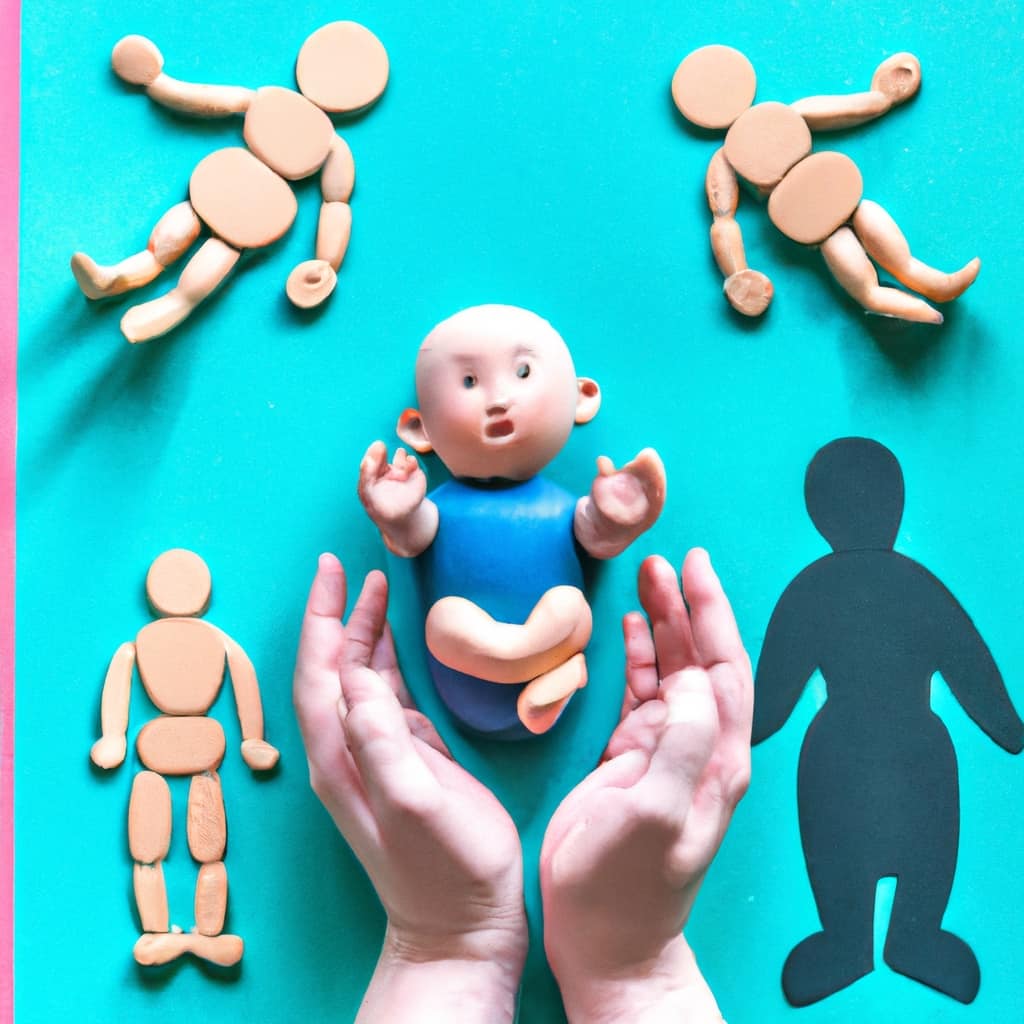
Key Takeaways
- Wood is a durable and long-lasting material, making it a safe and non-toxic option for children’s toys.
- Organic cotton is a gentle and hypoallergenic material that promotes a healthier environment and supports fair trade practices.
- BPA-free plastic eliminates the risk of exposure to harmful chemicals and provides peace of mind for parents.
- Toys made from wood and organic cotton have a long lifespan and can be passed down to future generations, making them a sustainable and eco-friendly choice.
Wood
Wood is one of our favorite materials for children’s toys due to its durability and natural beauty. Wooden puzzles and wooden building blocks are classic toys that provide endless hours of entertainment and educational value for children.
Wooden puzzles aren’t only fun to play with, but they also help develop problem-solving and fine motor skills. They come in various shapes and sizes, catering to different age groups.
Wooden building blocks, on the other hand, encourage creativity and imagination. Children can build structures, towers, and even create their own mini worlds using these blocks.
Wood is a safe and non-toxic material, making it ideal for children’s toys. Its sturdy nature ensures that these toys can withstand rough play and last for years, making them a great investment for both parents and caregivers.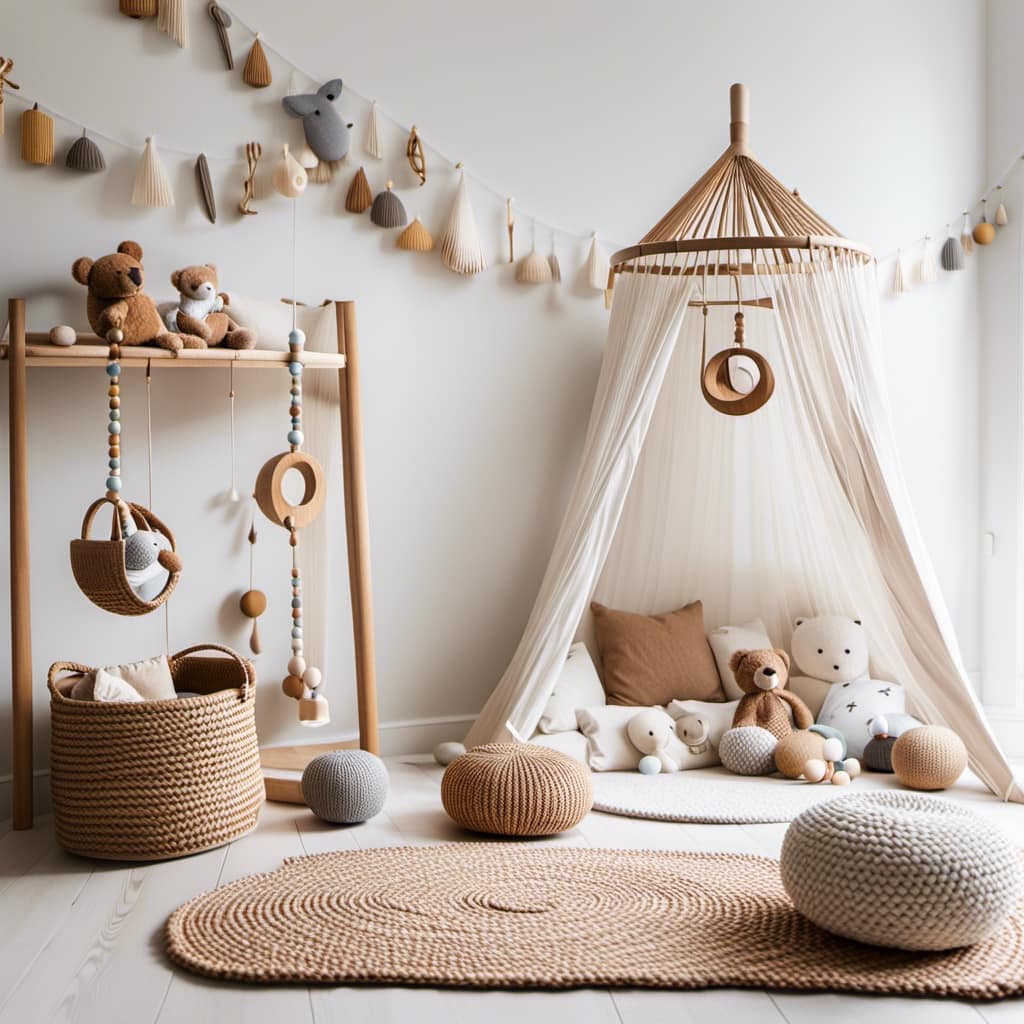
Organic Cotton
Moving on from wood, another excellent safe and non-toxic material for children’s toys is organic cotton. Organic cotton toys offer several benefits for both children and the environment. Here are some key points to consider:
- Chemical-free: Organic cotton is grown without the use of harmful pesticides or synthetic fertilizers, making it a safer option for children to play with.
- Hypoallergenic: Organic cotton is gentle on sensitive skin, making it suitable for children with allergies or sensitivities.
- Sustainable: Organic cotton farming practices promote soil health and biodiversity, reducing the overall impact on the environment.
The impact of organic cotton farming on the environment is significant. By avoiding the use of harmful chemicals, it helps preserve soil quality, reduces water pollution, and protects wildlife. Additionally, organic cotton production supports fair trade practices and ensures a safer working environment for farmers.
Choosing organic cotton toys not only promotes child safety but also contributes to a healthier planet for future generations.
BPA-Free Plastic
One option to consider for safe and non-toxic children’s toys is BPA-free plastic. BPA, or bisphenol A, is a chemical commonly found in plastic products that has been linked to various health risks, especially in children. BPA can leach out of plastic toys and enter the body when children put them in their mouths or handle them extensively.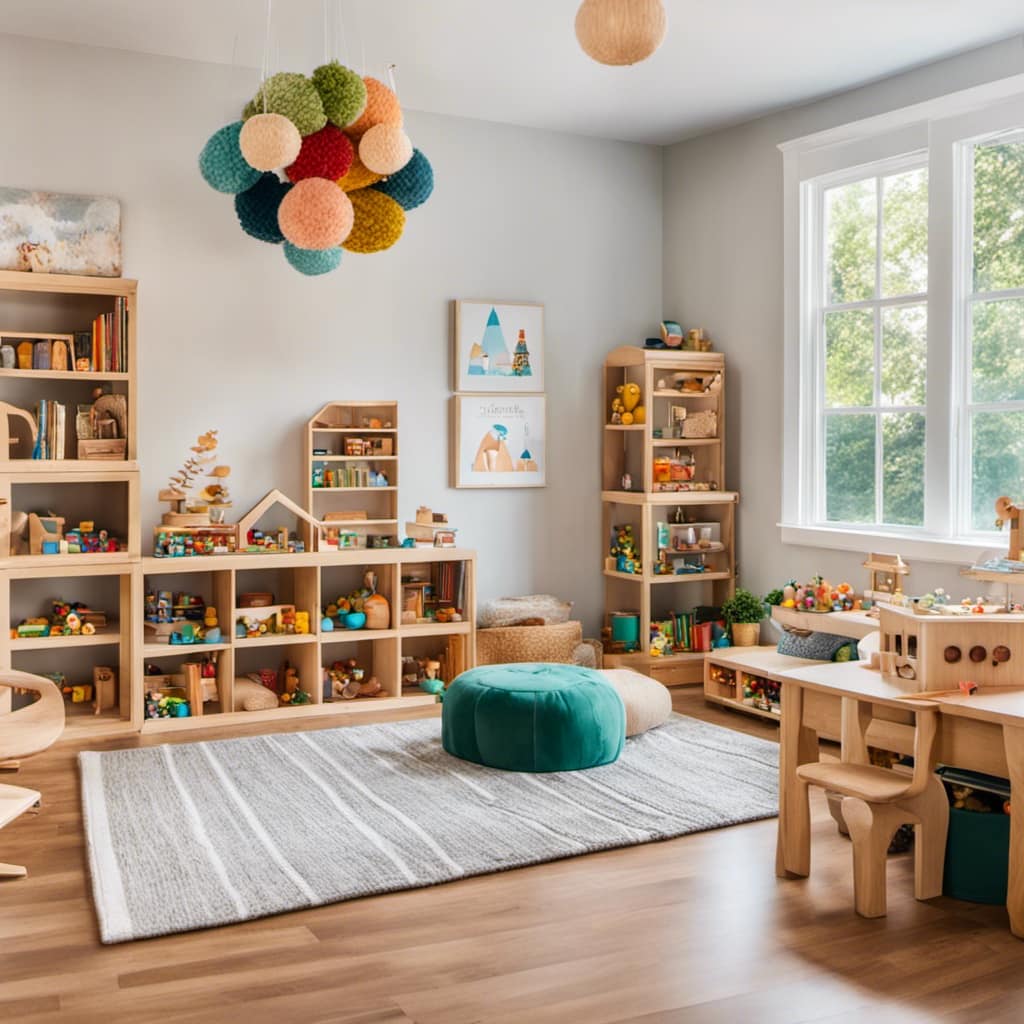
To address these concerns, manufacturers have started producing toys made from BPA-free plastic, which eliminates the risk of exposure to this harmful chemical. These eco-friendly alternatives provide parents with peace of mind, knowing that their children can play with toys that are safe and non-toxic.
When choosing children’s toys, it’s important to prioritize their health and well-being by opting for BPA-free plastic options.
Frequently Asked Questions
Are There Any Specific Safety Standards or Certifications That Parents Should Look for When Purchasing Wooden Toys for Their Children?
When purchasing wooden toys for our children, it’s important to look for safety standards and certifications. Reading labels helps ensure non-toxic materials. Be cautious of toxic finishes or paints that pose potential risks.
Is Organic Cotton Used as a Stuffing Material in Plush Toys Completely Free of Chemicals and Pesticides?
Organic cotton toys: Are they truly chemical free and safe? We’ve got the scoop. Choosing organic cotton for your little ones means you’re opting for a safer, non-toxic playtime experience.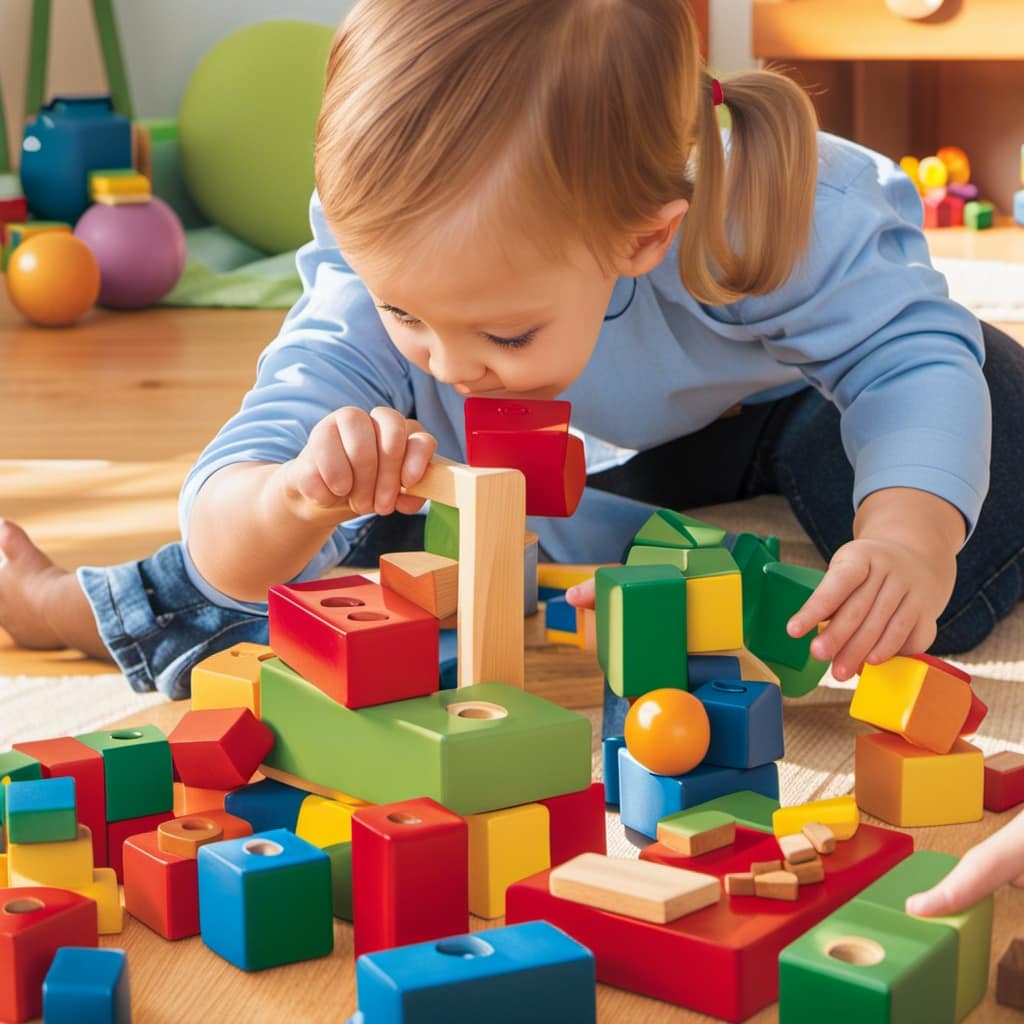
Can Bpa-Free Plastic Toys Still Contain Other Potentially Harmful Chemicals?
Yes, BPA-free plastic toys may still contain other potentially harmful chemicals. To minimize concerns about chemical exposure, consider alternative materials for children’s toys, such as wooden or organic cotton options, which are eco-friendly.
How Can Parents Ensure That the Wooden Toys They Purchase Are Not Treated With Toxic Finishes or Paints?
Parents play a vital role in promoting safe play for their children. Understanding the importance of non-toxic toys is crucial. To ensure wooden toys are safe, research brands that prioritize natural, non-toxic finishes and paints.
Are There Any Potential Health Risks Associated With the Use of Organic Cotton Toys, Such as Allergies or Sensitivities?
There may be potential health risks associated with organic cotton toys, such as allergies or sensitivities. It’s important for parents to be aware and consider any potential reactions when choosing toys for their children.
Conclusion
In conclusion, when it comes to choosing safe and non-toxic materials for children’s toys, nothing beats the timeless charm of wood. Its durability and natural beauty make it a perfect choice for little ones.

Additionally, organic cotton provides a soft and chemical-free option for cuddly toys.
And let’s not forget about BPA-free plastic, which offers a safe and sturdy alternative for certain toys.
With these top three materials, you can ensure that your child’s toys are both fun and safe.
Mila, a gifted writer with a heart brimming with enthusiasm for child development and playful learning, is the creative force behind the enchanting narratives and insightful articles that grace Toddler Ride On Toys. With a background in early childhood education and a genuine passion for nurturing young minds, Mila weaves words that captivate, educate, and inspire parents, caregivers, and educators.
Montessori Toys
Top 5 Quality Producers of Learning Toys

We have searched the market to bring you the top educational toy manufacturers. These five companies excel in creating toys that are educational and engaging for children.
Melissa & Doug, PlanToys, Hape, Grimm’s, and Learning Resources have all earned their spots on our prestigious list. Get ready to discover the finest quality toys that will inspire learning and imagination in your little ones.
Let’s dive into the world of these outstanding producers and explore their exceptional creations.
Key Takeaways
- Melissa & Doug, PlanToys, Hape, Grimm’s, and Learning Resources are the top producers of learning toys.
- These brands prioritize sustainability, using organic materials, non-toxic dyes, and child-safe finishes.
- The learning toys offered by these brands stimulate cognitive, physical, and social skills, as well as creativity and problem-solving abilities.
- Incorporating learning resources in early childhood education enhances problem-solving skills, critical thinking abilities, effective communication, creativity, and independent exploration.
Melissa & Doug
The article discusses the quality of learning toys produced by Melissa & Doug. Melissa & Doug is a renowned brand that offers a wide range of learning toys for early childhood development. These toys provide numerous benefits for children’s learning and development.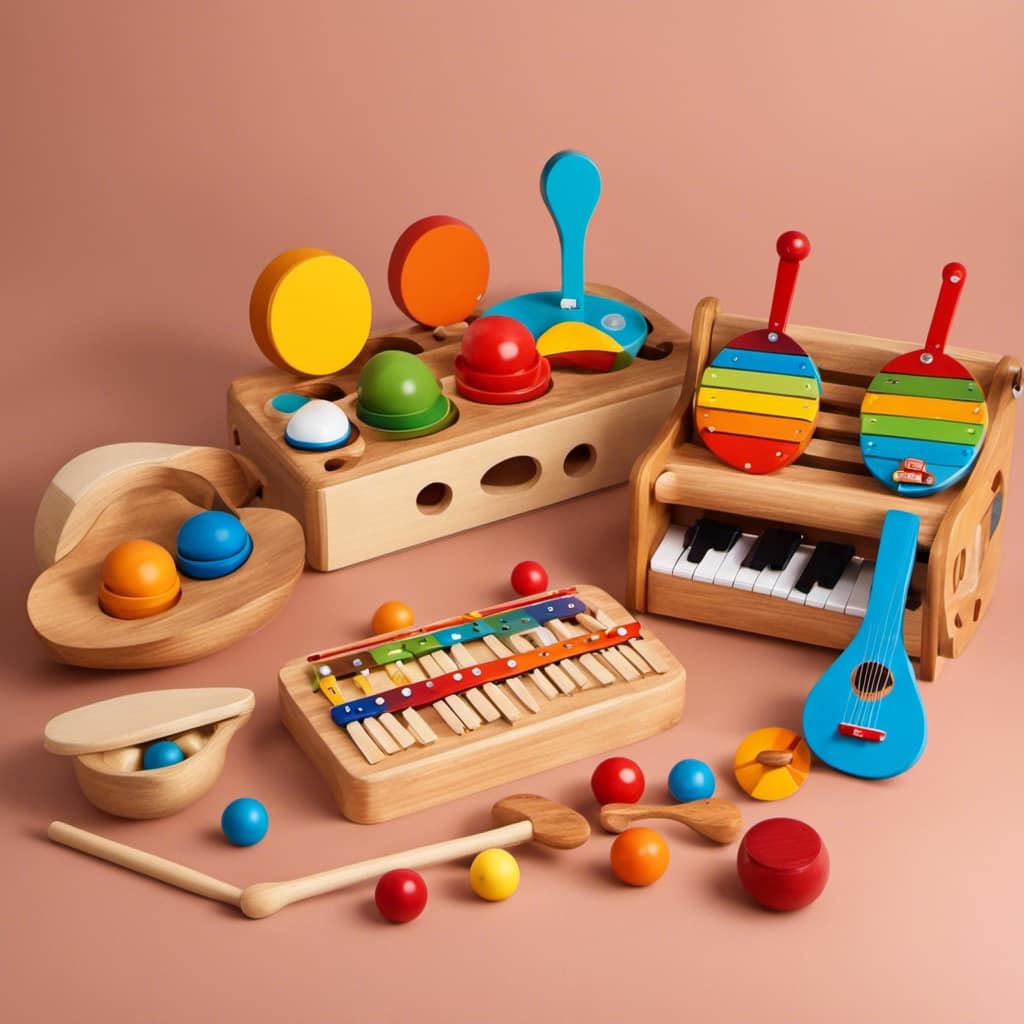
One of the key advantages of Melissa & Doug learning toys is their ability to promote imaginative play. Through imaginative play, children can explore their creativity, problem-solving skills, and social interactions. These toys encourage children to use their imagination, which is crucial for their cognitive and emotional growth.
Melissa & Doug toys are designed to engage children in hands-on activities, allowing them to learn through exploration and play. Transitioning into the subsequent section about plantoys, it’s important to consider the different approaches and features offered by various toy producers.
PlanToys
Introducing PlanToys, a leading producer of learning toys that prioritize sustainability and child development. PlanToys is known for their eco-friendly toys and sustainable play options, making them a top choice for environmentally conscious parents.
PlanToys takes pride in their commitment to using organic materials and non-toxic dyes in their products. They also prioritize sustainable manufacturing practices, ensuring that their toys are made in an environmentally friendly manner.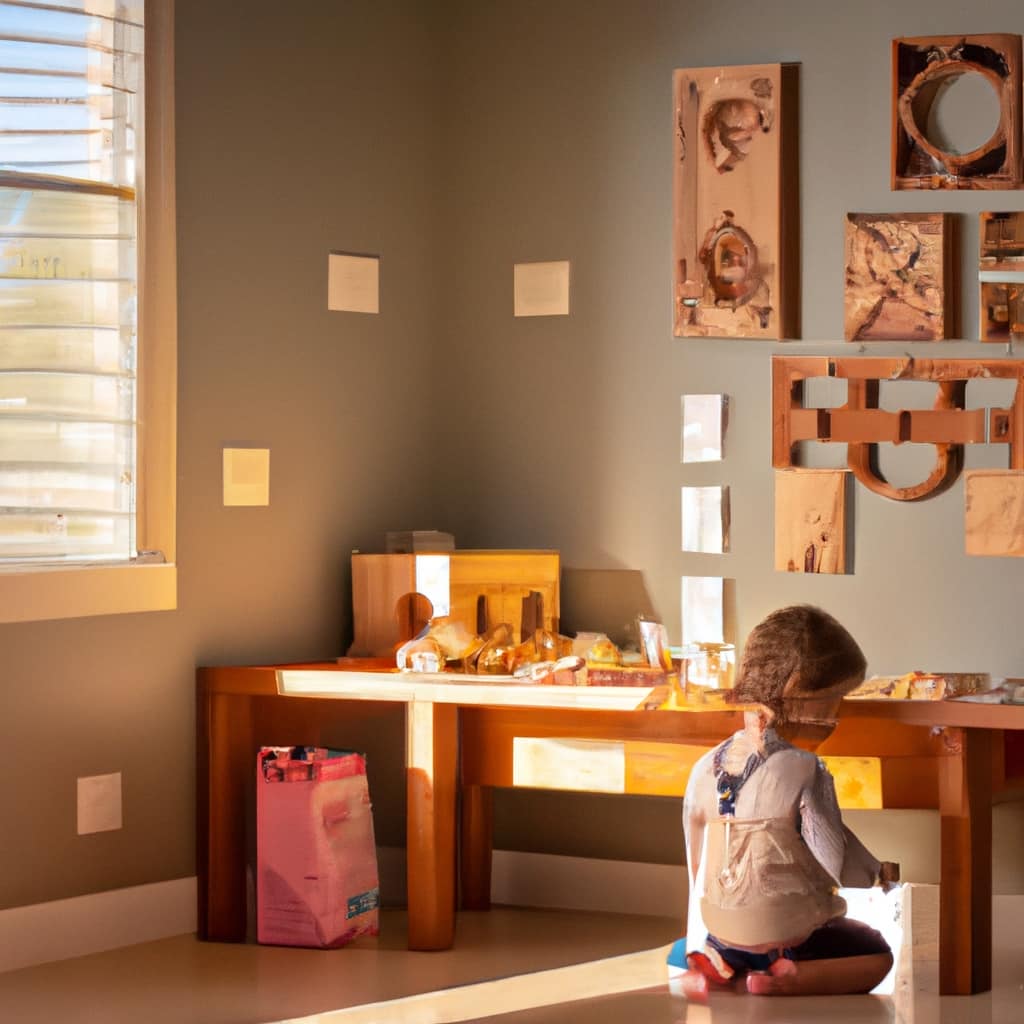
One of the key features of PlanToys is their focus on child development. Their toys are designed to stimulate different aspects of a child’s growth, including cognitive, physical, and social skills. From building blocks to puzzles, PlanToys offers a wide range of options that encourage creativity, problem-solving, and imagination.
With their dedication to sustainability and child development, PlanToys is a brand that not only provides high-quality learning toys, but also contributes to a better future for our planet.
Hape
Continuing our exploration of top quality producers of learning toys, let’s now turn our attention to Hape, a brand that shares a similar commitment to sustainability and child development.
Hape is known for their innovative learning toys that engage children in interactive play while promoting their cognitive, physical, and social development.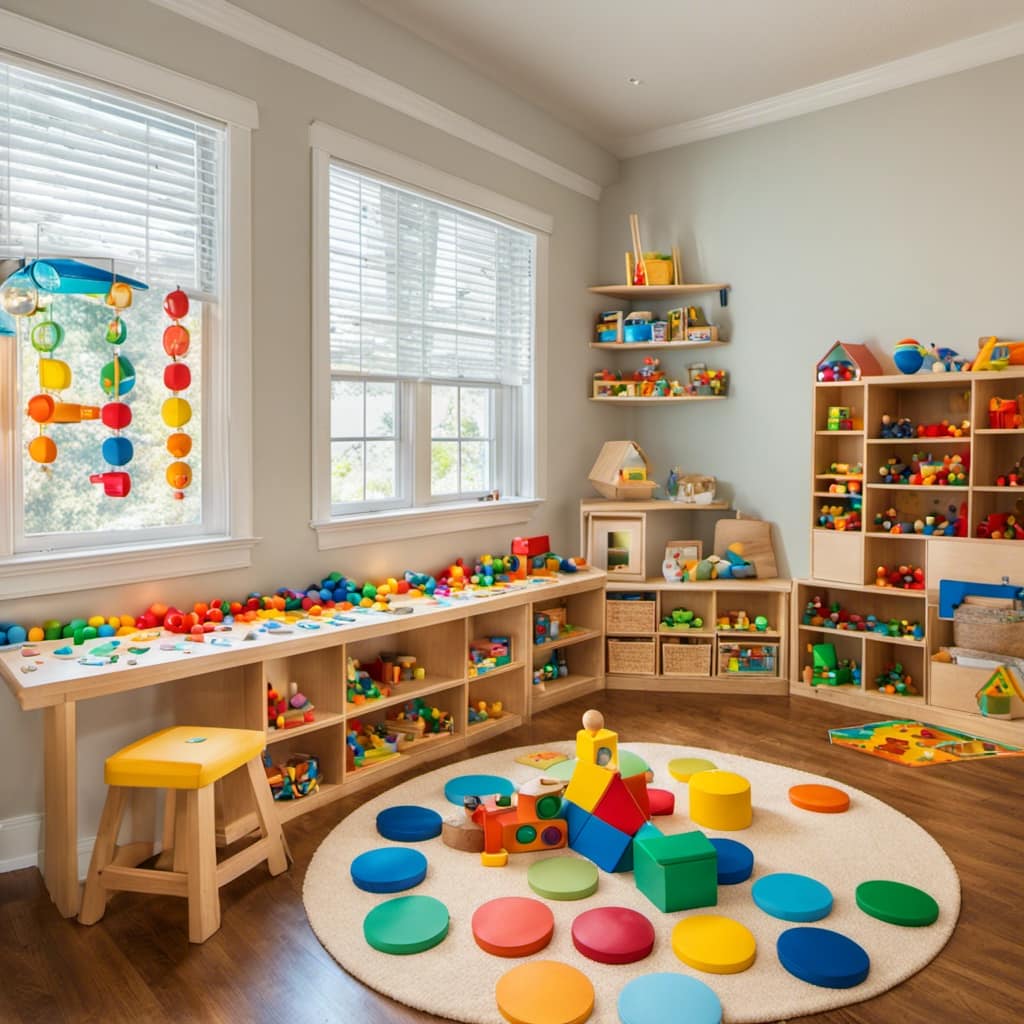
Hape offers a wide range of toys that cater to various age groups and developmental stages. From wooden puzzles and building blocks to musical instruments and pretend play sets, Hape toys provide endless opportunities for children to explore, learn, and grow.
What sets Hape apart is their dedication to using sustainable materials and non-toxic, child-safe finishes. Their toys are designed to withstand years of play, ensuring durability and longevity. Additionally, Hape toys encourage creativity, problem-solving skills, and imaginative play, fostering a well-rounded development in children.
With Hape’s innovative learning toys, children can have fun while acquiring essential skills and knowledge. By investing in Hape toys, parents can provide their children with the tools they need to thrive and succeed.
Grimm’s
Now let’s delve into Grimm’s, another quality producer of learning toys that complements Hape’s commitment to sustainability and child development.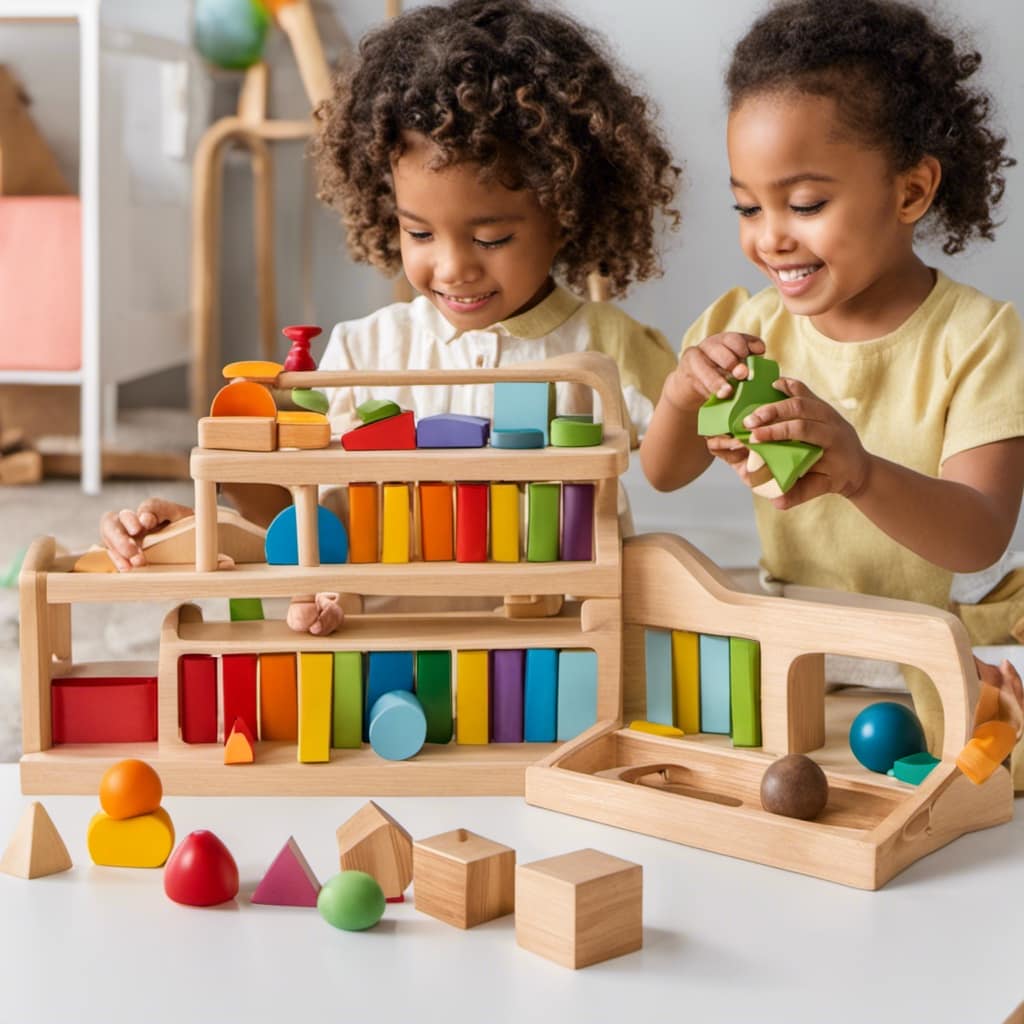
Grimm’s is renowned for their unique wooden toys that promote imaginative play and open-ended learning. Here are some key benefits of Grimm’s toys:
-
Encourages Creativity: Grimm’s toys are designed to inspire children’s creativity and imagination. With their vibrant colors and versatile shapes, children can explore endless possibilities and create their own stories and scenarios.
-
Enhances Problem-Solving Skills: The open-ended nature of Grimm’s toys encourages children to think critically and find solutions to different challenges. Whether it’s building structures or creating intricate patterns, children develop problem-solving skills while having fun.
-
Promotes Fine Motor Skills: Manipulating and arranging the various wooden pieces in Grimm’s toys helps children refine their fine motor skills. From stacking blocks to arranging puzzles, these toys provide hands-on experiences that strengthen hand-eye coordination and dexterity.

-
Sustainable and Eco-Friendly: Grimm’s is committed to sustainability and uses high-quality, natural materials such as wood and non-toxic paints. Their toys are ethically produced, ensuring a safe and eco-friendly playtime experience for children.
Grimm’s toys offer a world of possibilities for children, fostering their development while providing endless hours of engaging play.
Learning Resources
Learning Resources provides a wide range of educational toys and materials designed to enhance children’s learning experiences. Incorporating learning resources in early childhood education offers numerous benefits. These resources help children develop essential skills such as problem-solving, critical thinking, communication, and creativity. They also promote cognitive development, improve fine motor skills, and enhance hand-eye coordination. By engaging with learning toys, children are encouraged to explore, experiment, and discover new concepts independently.
Choosing the right learning toys for your child’s development is crucial. Consider their age, interests, and developmental stage. Look for toys that are age-appropriate and align with their learning goals. Consider toys that encourage imaginative play, promote sensory exploration, and offer hands-on learning experiences. Look for toys that are durable, safe, and made from high-quality materials.
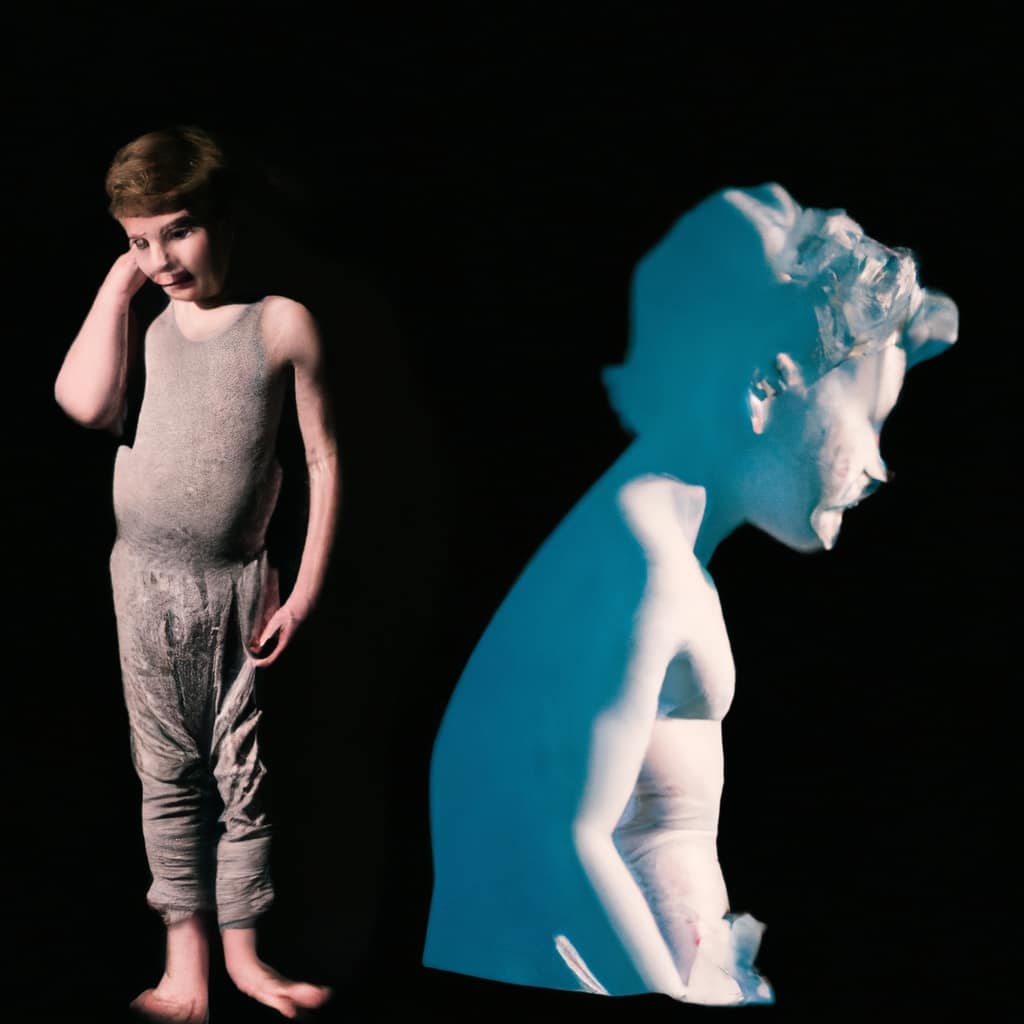
Additionally, involve your child in the decision-making process to foster their independence and encourage their engagement with the learning resources.
Frequently Asked Questions
What Are the Specific Age Ranges That Melissa & Doug’s Learning Toys Cater To?
Melissa & Doug’s learning toys cater to specific age ranges, offering advantages for each group. The toys are designed to promote cognitive development, fine motor skills, and creative thinking in toddlers, preschoolers, and elementary school children.
Are Plantoys’ Learning Toys Made From Sustainable Materials?
Yes, PlanToys’ learning toys are made from sustainable materials. Using eco-friendly materials in children’s toys not only benefits the environment but also teaches kids about sustainability and responsible consumption.
Does Hape Offer Any Educational Resources or Guides to Accompany Their Learning Toys?
Incorporating educational resources with learning toys has several benefits. Parents can utilize educational guides to enhance their child’s learning experience with Hape toys by providing additional information, activities, and guidance for interactive and educational play.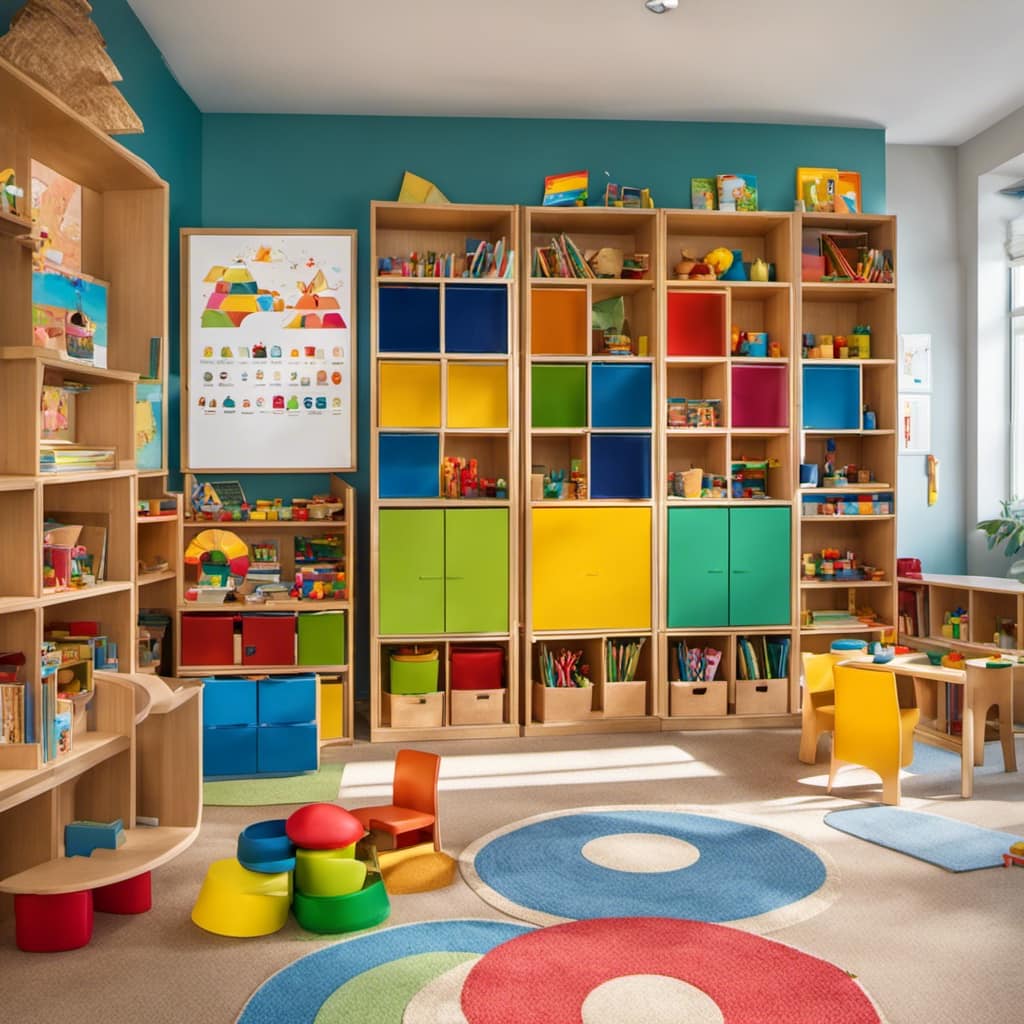
Are Grimm’s Learning Toys Suitable for Children With Special Needs?
Grimm’s learning toys for children with sensory needs can be adapted to suit different abilities. We can explore ways to modify the toys to provide a stimulating and inclusive learning experience for all children.
Can Learning Resources’ Learning Toys Be Used for Homeschooling Purposes?
Using learning toys for homeschooling has both pros and cons. They can enhance educational development by promoting active learning, but may also limit social interaction. Consider the impact on your child’s overall learning experience.
Conclusion
In conclusion, when it comes to quality producers of learning toys, Melissa & Doug, PlanToys, Hape, Grimm’s, and Learning Resources stand out for their commitment to creating educational and engaging products.
These brands offer a wide range of toys that promote cognitive development, creativity, and problem-solving skills in children. With their attention to detail, use of sustainable materials, and innovative designs, these companies have earned their reputation as leaders in the industry.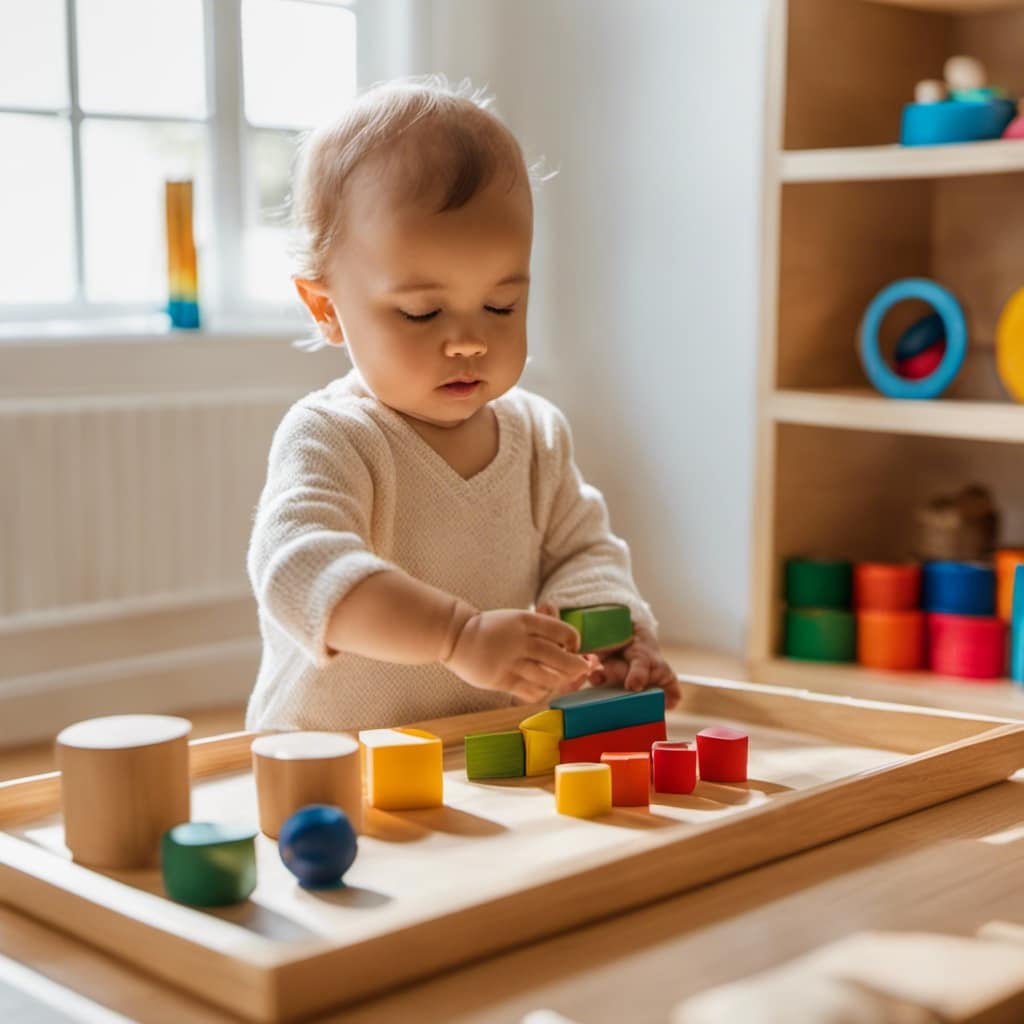
By investing in toys from these producers, parents can ensure that their children receive the best tools for learning and growth.
Mila, a gifted writer with a heart brimming with enthusiasm for child development and playful learning, is the creative force behind the enchanting narratives and insightful articles that grace Toddler Ride On Toys. With a background in early childhood education and a genuine passion for nurturing young minds, Mila weaves words that captivate, educate, and inspire parents, caregivers, and educators.
Montessori Toys
5 Best Economical Options for Kids’ Montessori Toys
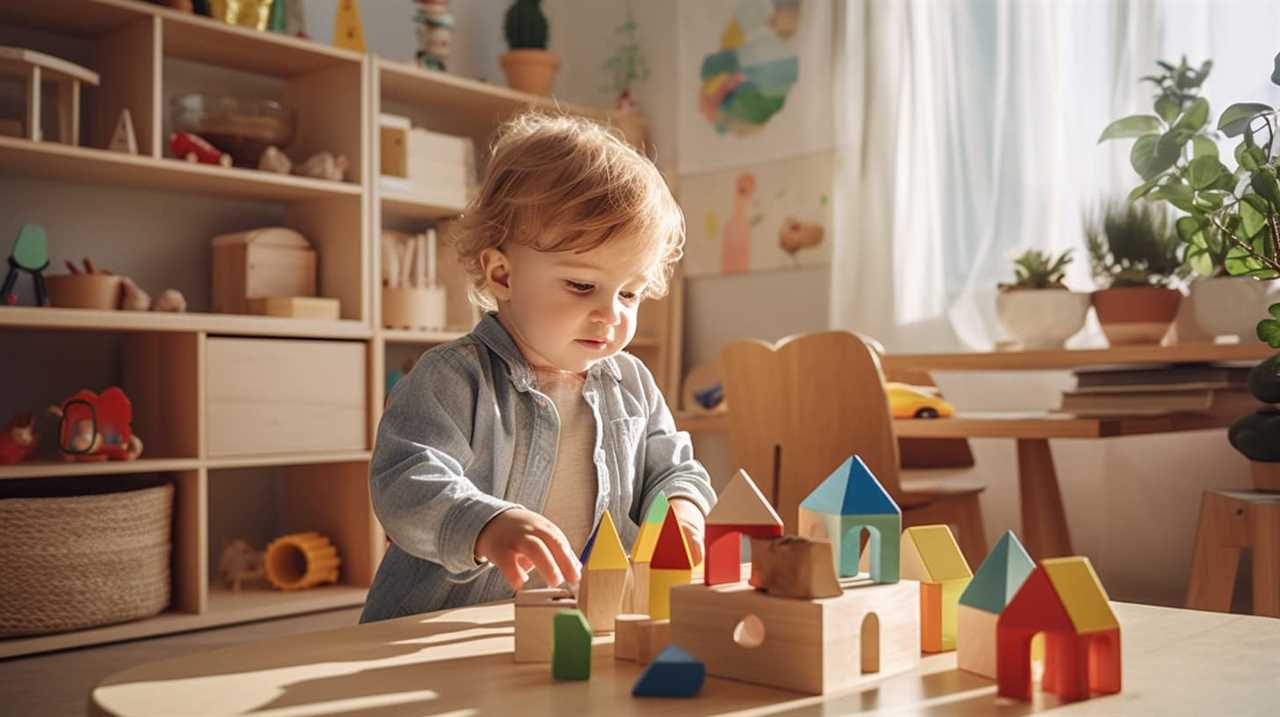
Finding affordable Montessori toys for kids can be a challenge. But fret not! We have put together a list of the top budget-friendly options just for you.
With our expert knowledge and research, we’ve found the top brands that won’t break the bank. Get ready to provide quality educational toys for your little ones without draining your wallet.
Let’s dive in and explore the five best economical options for kids’ Montessori toys.
Key Takeaways
- Materials used in construction, complexity of design, brand reputation, and quality and durability of materials are factors that affect Montessori toy costs.
- Lovevery, Hape, Melissa & Doug, and PlanToys are top affordable Montessori toy brands known for their quality and child-friendly designs.
- To find budget-friendly Montessori toys, consider open-ended toys, DIY options, budget-friendly subscription services, sales and discounts, and second-hand options from online marketplaces and thrift stores.
- Cost-effective DIY Montessori toy ideas include repurposing household items, finding items at thrift stores, DIY projects, and using nature-inspired toys and everyday household objects.
Factors Affecting Montessori Toy Costs
Factors that impact Montessori toy costs include materials, complexity, and brand reputation.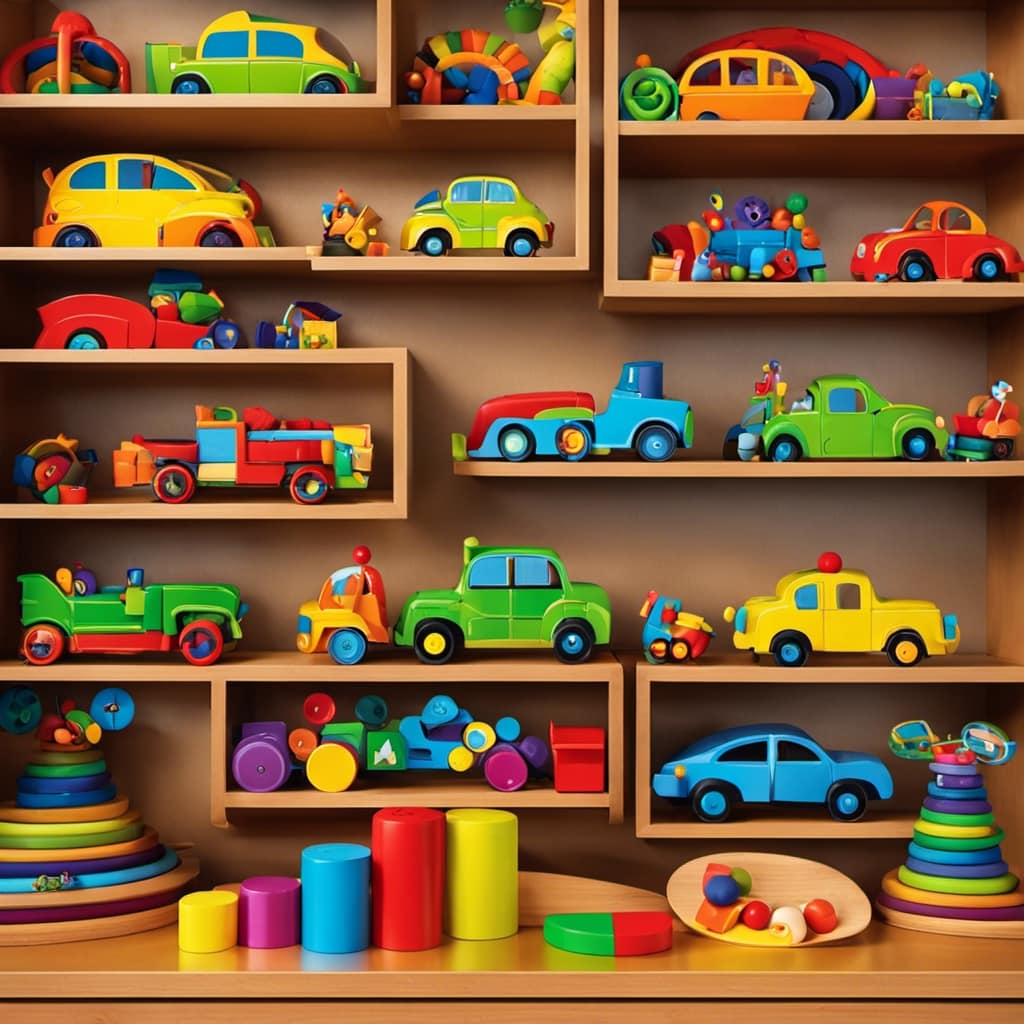
The quality of materials used in the construction of Montessori toys plays a significant role in determining their cost. High-quality materials, such as sustainably sourced wood or natural fabrics, tend to be more expensive, but they also ensure durability and safety for your child. On the other hand, cheaper materials may compromise the toy’s quality and longevity.
Brand reputation also influences Montessori toy prices. Well-established brands with a proven track record of producing high-quality educational toys are likely to charge more for their products. This is because they’ve invested in research and development, ensuring that their toys meet the educational standards of the Montessori method. However, there are also smaller, independent brands that offer affordable options without compromising on quality.
Understanding the impact of material quality and brand reputation on Montessori toy costs can help you make informed decisions when selecting toys for your child. By considering these factors, you can strike a balance between affordability and quality, ensuring that your child receives the best educational experience without breaking the bank.
Top Affordable Montessori Toy Brands
One of our favorite affordable Montessori toy brands is Lovevery. Lovevery offers Montessori inspired toy subscription services that deliver age-appropriate toys right to your doorstep. Their toys are designed to stimulate learning and promote development in children from birth to age four. Lovevery toys are crafted with high-quality materials and are designed to be durable, ensuring they can withstand the active play of young children.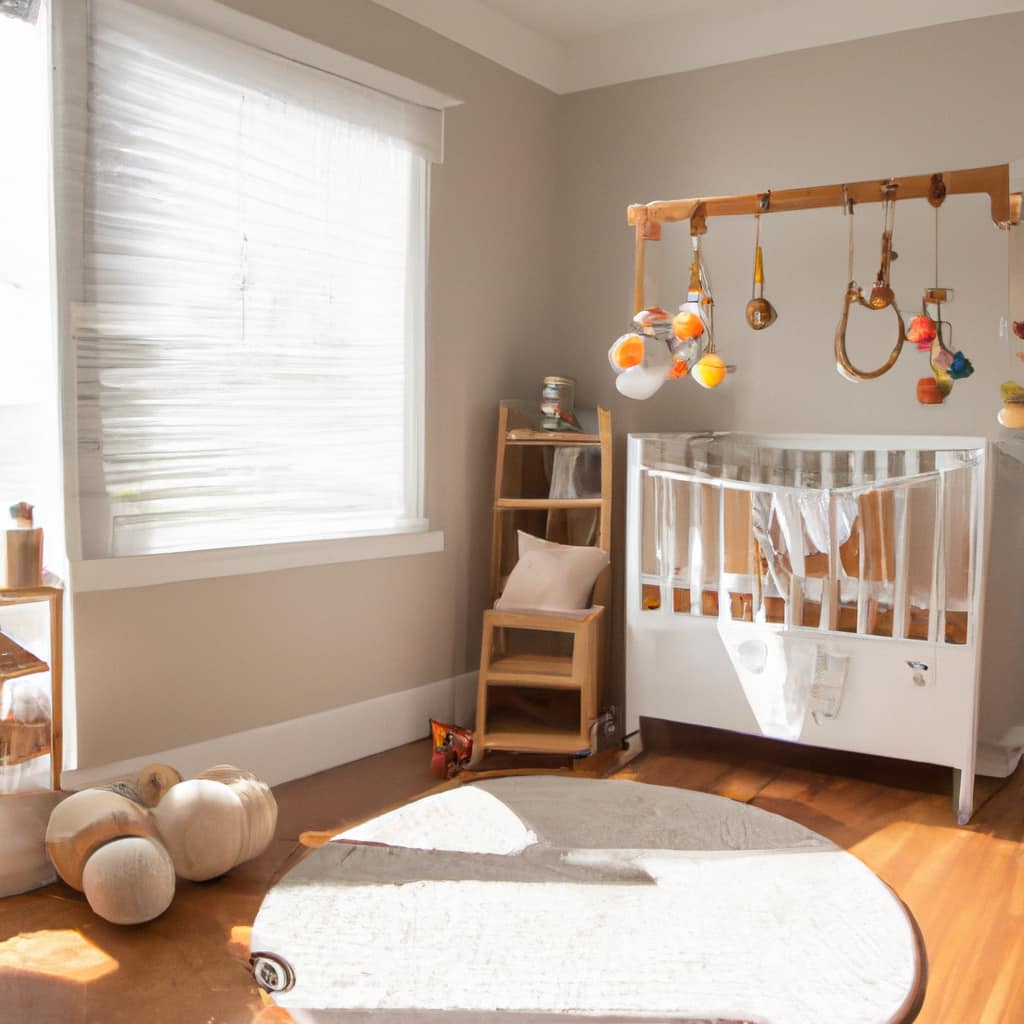
Another great option for affordable Montessori toys is to explore second-hand options. Websites such as eBay, Craigslist, and local buy/sell groups often have listings for gently used Montessori toys at a fraction of the original price. By opting for second-hand Montessori toys, you not only save money but also contribute to a sustainable and eco-friendly approach to toy shopping.
Budget-Friendly Montessori Toy Recommendations
After exploring affordable Montessori toy brands such as Lovevery and considering second-hand options, we can now discuss some budget-friendly recommendations for Montessori toys.
When it comes to affordable Montessori toy alternatives, there are a few options to consider. Firstly, you can opt for open-ended toys that can be used in multiple ways, such as wooden blocks or stacking rings. These toys promote creativity and problem-solving skills while being cost-effective.
Another budget-friendly option is to DIY Montessori-inspired toys using materials you already have at home. Repurposing everyday objects like empty containers or fabric scraps can make for engaging and educational toys.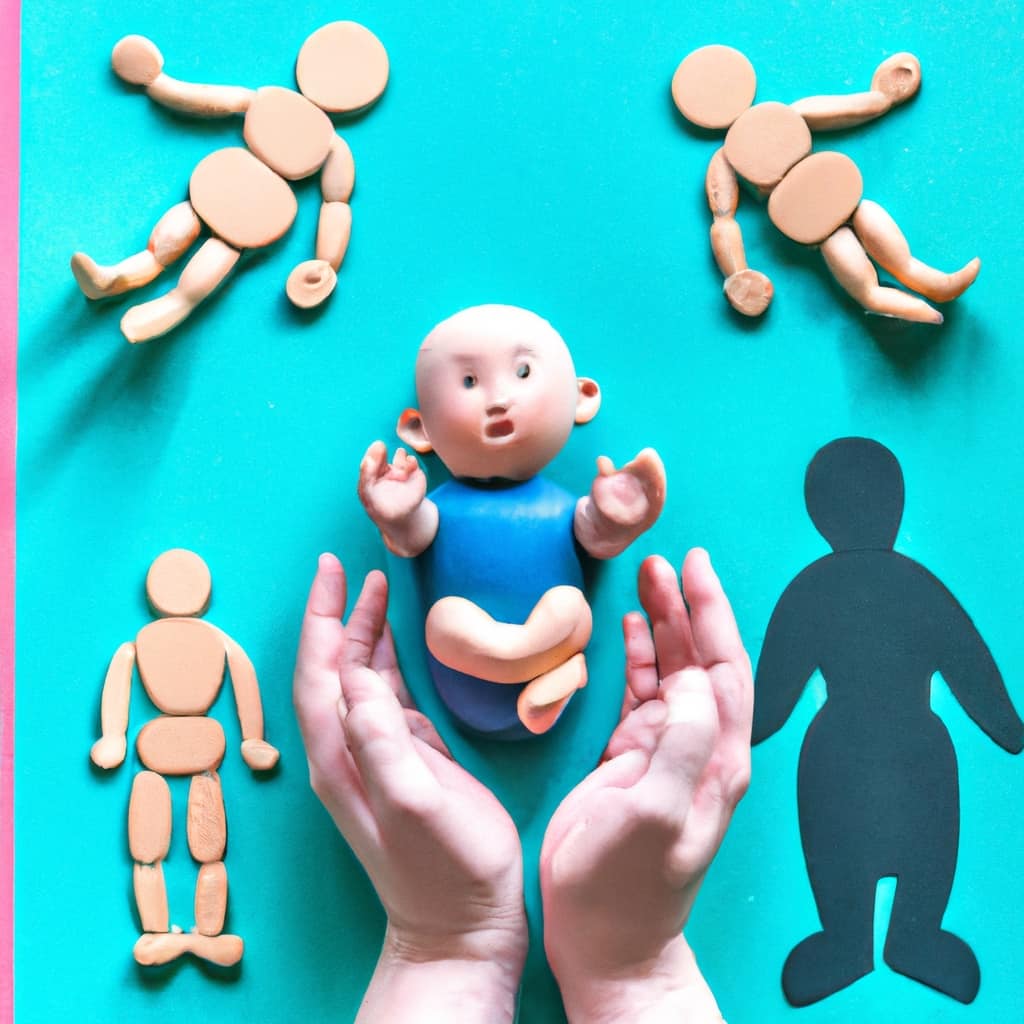
Additionally, some companies offer budget-friendly Montessori toy subscription services, which provide a variety of age-appropriate toys each month at a lower cost than purchasing individual toys. These subscription services allow your child to experience a range of Montessori-inspired activities without breaking the bank.
Tips for Finding Affordable Montessori Toys
To maximize our budget and find affordable Montessori toys, we can utilize effective strategies for sourcing cost-effective options. Here are three tips for finding affordable Montessori toys:
-
Secondhand Montessori toys: Consider purchasing gently used Montessori toys from online marketplaces, local thrift stores, or through local parent groups. Many families sell or donate their gently used toys, allowing you to save money while still providing your child with quality Montessori materials.
-
Sales and discounts on Montessori toys: Keep an eye out for sales and discounts on Montessori toys from various retailers. Sign up for newsletters or follow social media accounts of Montessori toy brands to stay updated on any promotions or special offers. This way, you can snag some great deals and save money on your purchases.
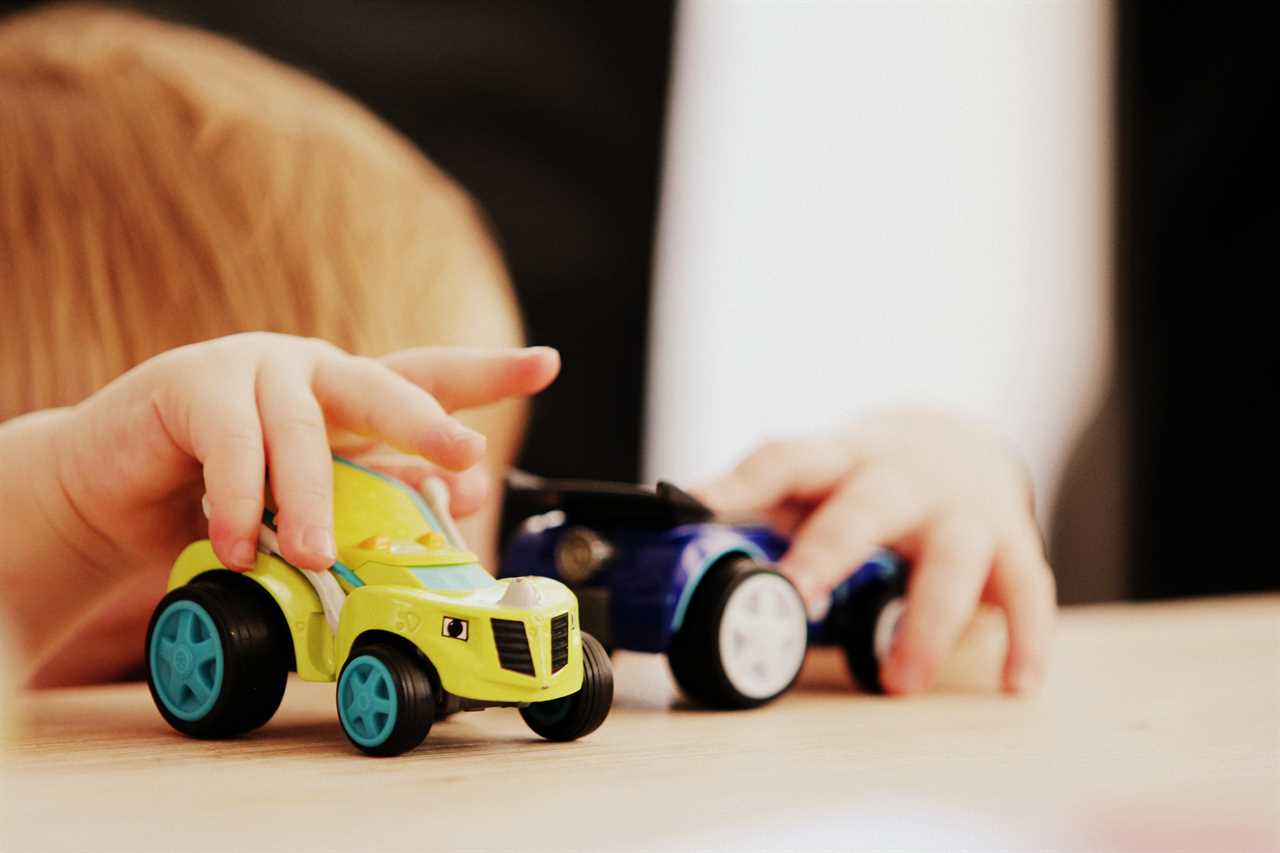
-
DIY Montessori toys: Get creative and make your own Montessori toys using materials you already have at home. There are plenty of DIY Montessori toy ideas available online that are budget-friendly and can be customized to suit your child’s interests and developmental needs.
Cost-Effective DIY Montessori Toy Ideas
Let’s explore some cost-effective DIY Montessori toy ideas that you can easily create at home.
One great option is to upcycle everyday items into Montessori toys. For example, you can turn old cardboard boxes into shape sorters or sensory bins by cutting out different holes and adding various textures.
Another idea is to repurpose empty containers and fill them with different objects, such as dried beans or buttons, for a DIY sound matching game.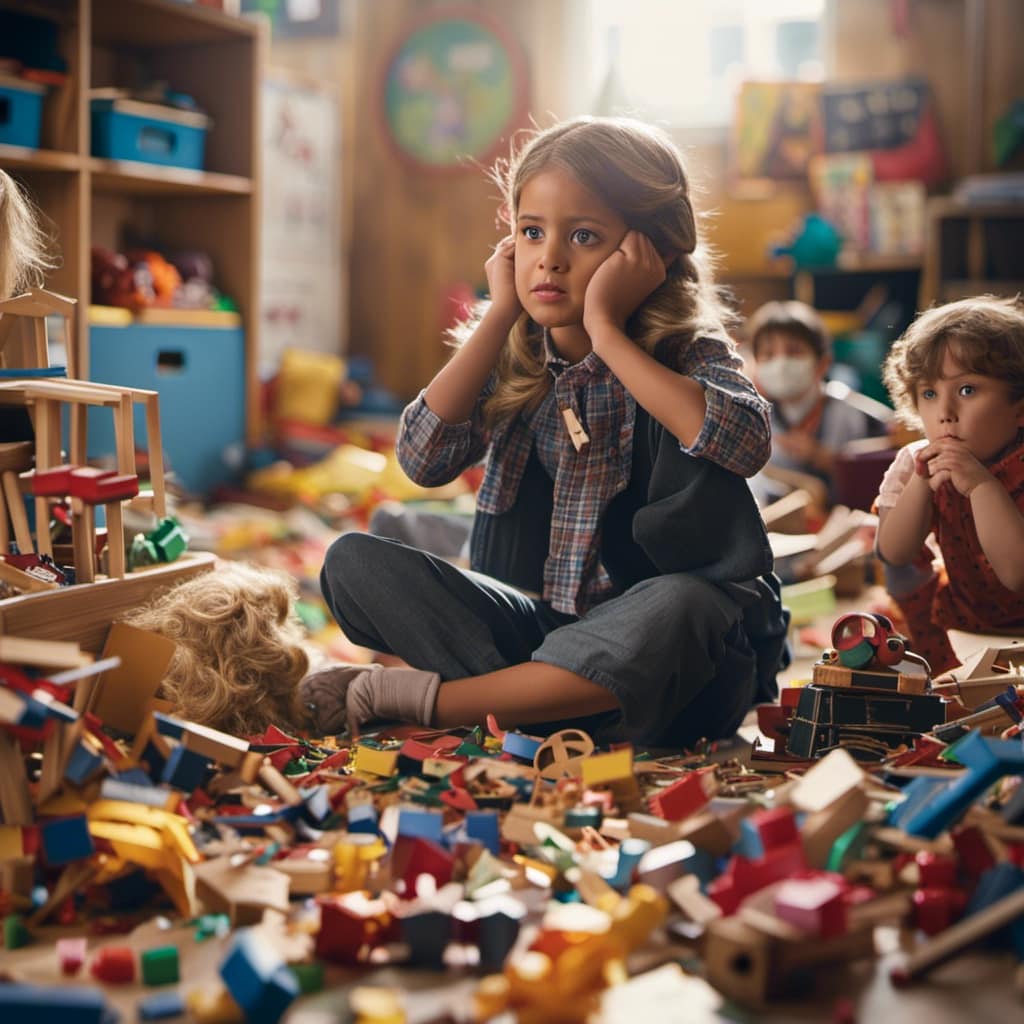
Thrift stores are also a great resource for finding affordable Montessori toys. Look for items like wooden puzzles, stacking toys, or small containers that can be used for sorting activities. With a little creativity and some paint, you can easily transform these thrift store finds into Montessori-inspired toys.
By using upcycled materials and shopping at thrift stores, you can create a variety of Montessori toys without breaking the bank. These DIY projects not only save you money but also promote sustainability and encourage resourcefulness.
Frequently Asked Questions
Are Montessori Toys Only Suitable for Young Children or Can Older Kids Benefit From Them as Well?
Montessori toys are not limited to young children; older kids can also benefit from them. Montessori toys offer unique benefits such as promoting independence and critical thinking, which traditional toys may not provide.
How Long Do Montessori Toys Typically Last Before Needing to Be Replaced?
Montessori toys can last a long time, but their lifespan depends on various factors like quality, materials, and how they are used. It’s important to choose durable toys that can withstand repeated play.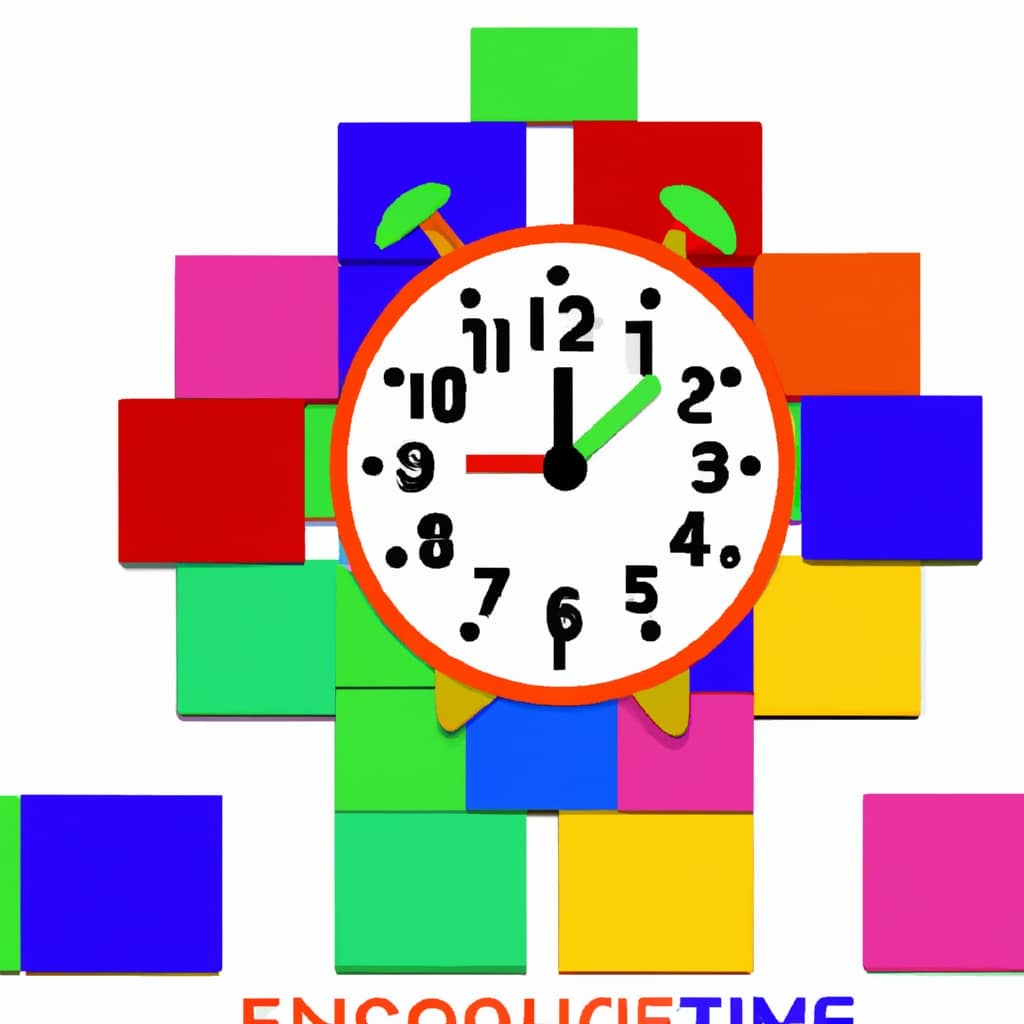
Can Montessori Toys Be Used in a Traditional Classroom Setting or Are They Only for Home Use?
Montessori toys can be used in a traditional classroom setting, not just at home. They offer numerous benefits for older kids, such as fostering independence, promoting problem-solving skills, and encouraging hands-on learning.
Are There Any Safety Concerns to Consider When Using Montessori Toys?
When it comes to Montessori toys, safety concerns are important to consider. However, the benefits for older kids are worth it. Let’s explore how to ensure a safe and enriching play environment.
What Are Some Alternatives to Montessori Toys That Offer Similar Educational Benefits at a Lower Cost?
Looking for budget-friendly alternatives for Montessori toys? Consider DIY Montessori-inspired toys. They offer similar educational benefits at a lower cost. Get creative and engage your little ones in cost-conscious educational play!
Conclusion
In conclusion, finding affordable Montessori toys doesn’t have to be a daunting task. By considering factors that affect costs, exploring budget-friendly brands, and utilizing cost-effective DIY ideas, parents can provide their children with enriching educational toys without breaking the bank.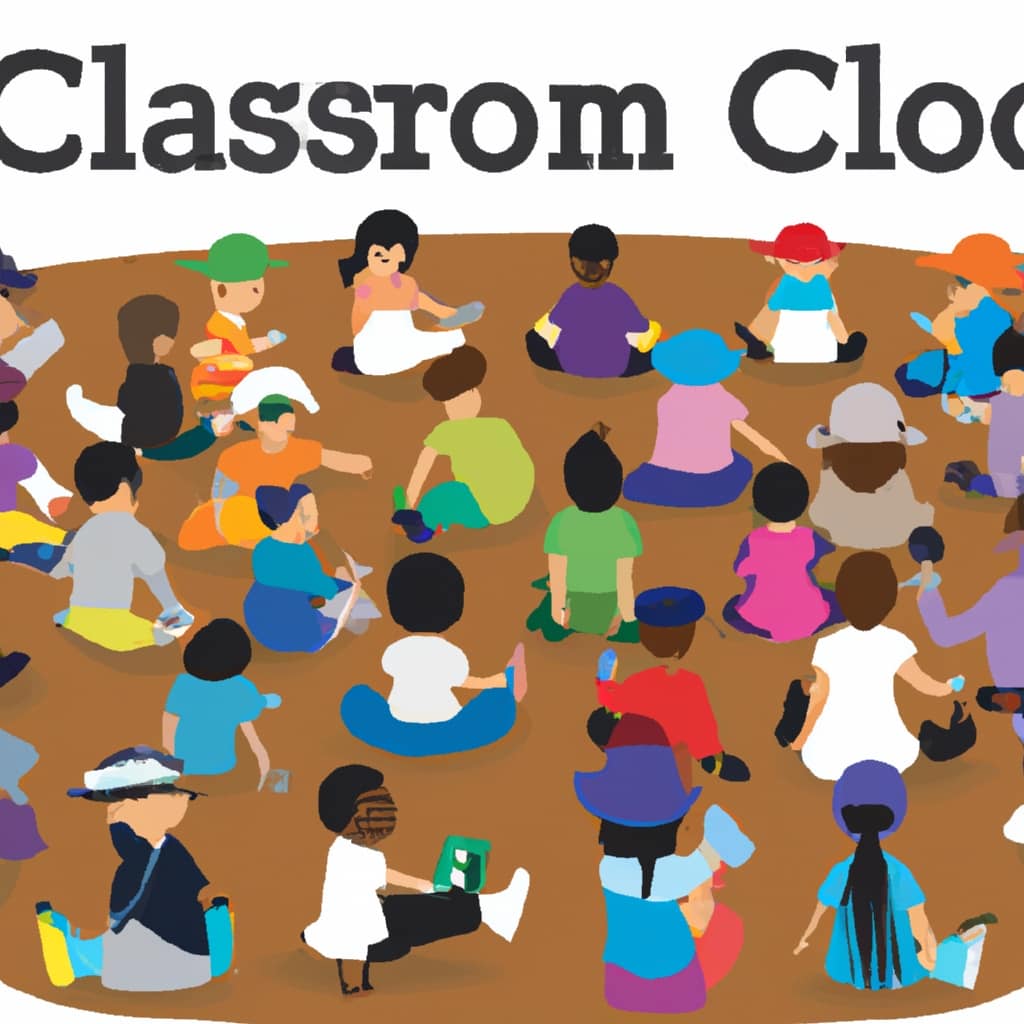
Remember, with a little creativity and resourcefulness, it’s possible to find the perfect Montessori toys that are both economical and engaging. So start your search today and watch your child’s learning journey flourish!
Mila, a gifted writer with a heart brimming with enthusiasm for child development and playful learning, is the creative force behind the enchanting narratives and insightful articles that grace Toddler Ride On Toys. With a background in early childhood education and a genuine passion for nurturing young minds, Mila weaves words that captivate, educate, and inspire parents, caregivers, and educators.
-

 Child Development3 months ago
Child Development3 months agoWhat Is a Theory in Child Development
-

 Child Development3 months ago
Child Development3 months agoThe Science Behind How Parents Affect Child Development
-

 Child Development3 months ago
Child Development3 months agoWhat Do You Do in Child Development Class in High School
-

 Child Development3 months ago
Child Development3 months agoHow Parenting Styles Affect Child Development
-

 Child Development3 months ago
Child Development3 months agoWhat Is Child Development?
-

 Child Development3 months ago
Child Development3 months agoHow Does Piaget’s Theory Impact Child Development
-

 Preschool Toys6 months ago
Preschool Toys6 months agoTop 8 Interactive Role-Play Toys for Preschoolers Reviewed
-
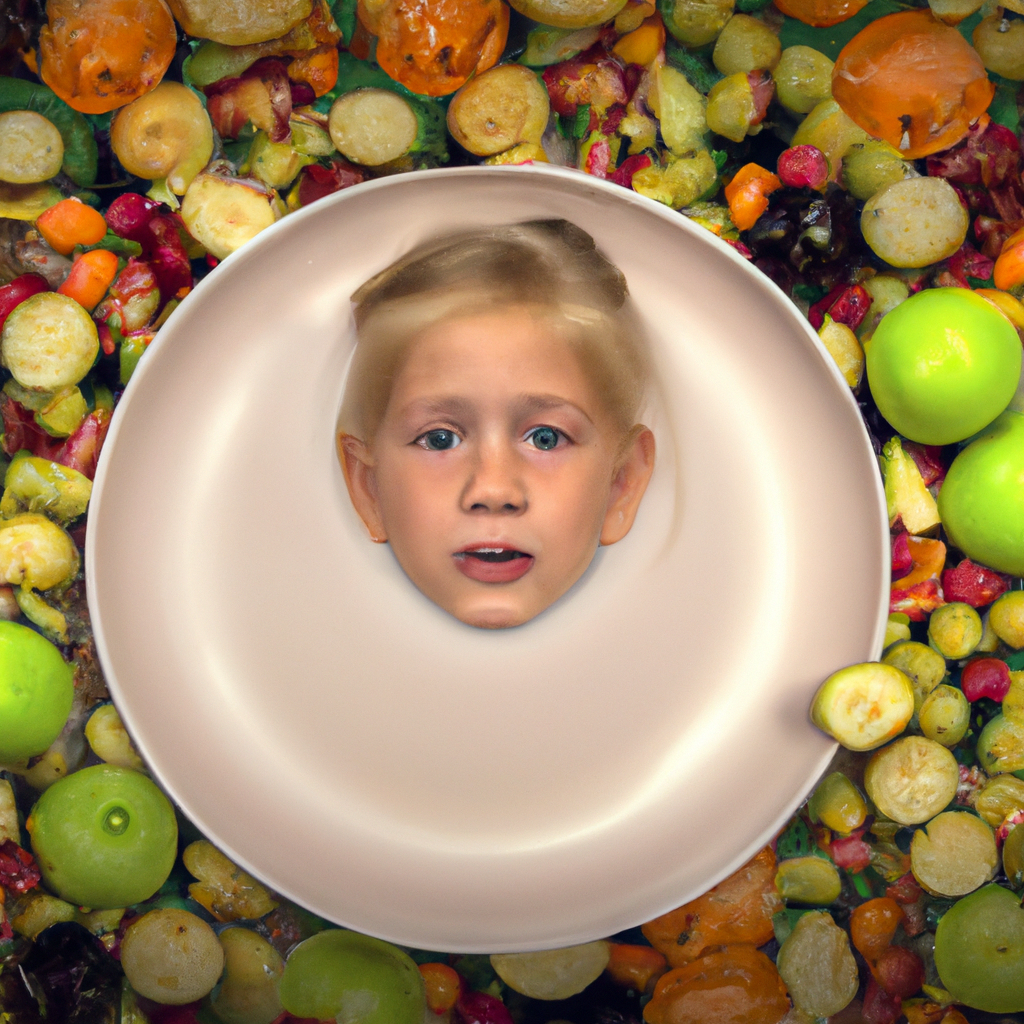
 Child Development3 months ago
Child Development3 months agoHow Does Food Insecurity Affect Child Development











